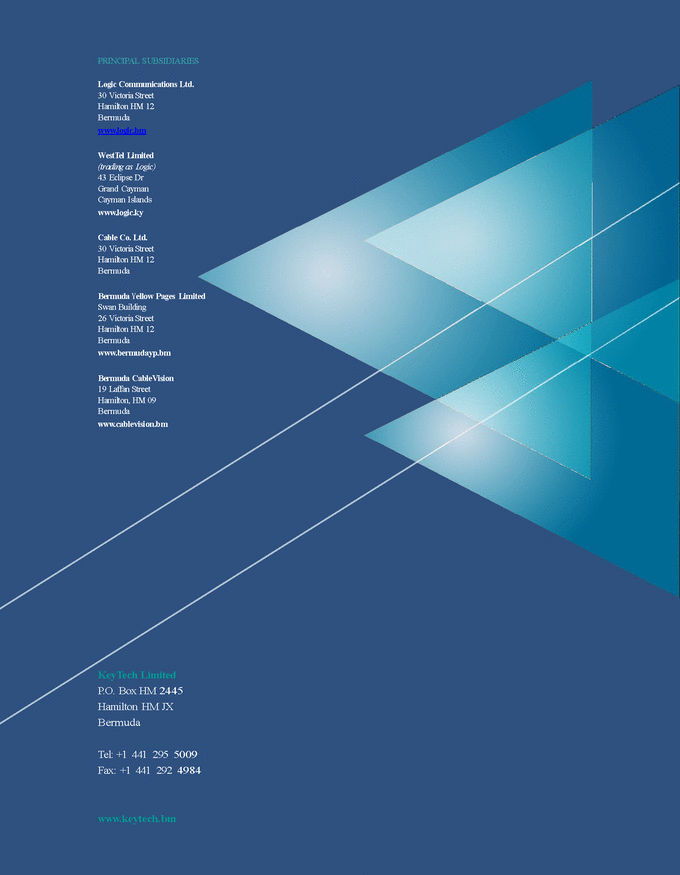Attached files
| file | filename |
|---|---|
| EX-99.3 - EX-99.3 - ATN International, Inc. | a16-14911_1ex99d3.htm |
| EX-99.2 - EX-99.2 - ATN International, Inc. | a16-14911_1ex99d2.htm |
| EX-23.1 - EX-23.1 - ATN International, Inc. | a16-14911_1ex23d1.htm |
| 8-K/A - 8-K/A - ATN International, Inc. | a16-14911_18ka.htm |
Exhibit 99.1
U n l o c k i n g a Wo r l d o f C o n n e c t i o n s Annual Report 2015

1 Independent Auditors’ Report 2 Consolidated Balance Sheet 3 Consolidated Statement of Comprehensive Income 5 Consolidated Statement of Changes in Equity 6 Consolidated Statement of Cash Flows 7 Notes to Consolidated Financial Statements 36 Company Officers & KeyTech Group Executives Contents
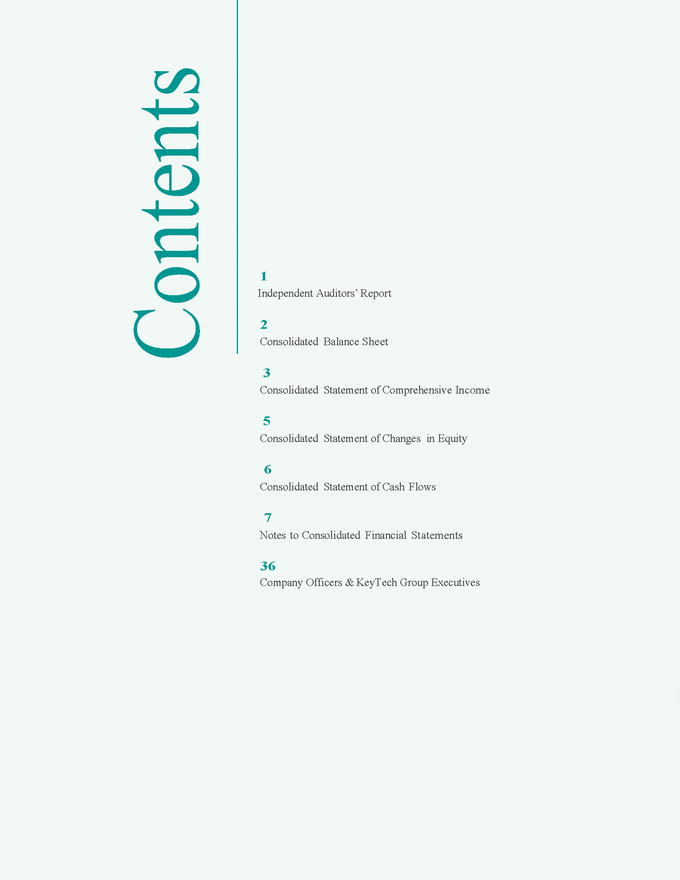
Independent Auditor’s Report To the Shareholders of KeyTech Limited We have audited the accompanying consolidated financial statements of KeyTech Limited and its subsidiaries, which comprise the consolidated balance sheet as of March 31, 2015, and the related consolidated statements of comprehensive income, of changes in equity and of cash flows for the year then ended. Management’s responsibility for the consolidated financial statements Management is responsible for the preparation and fair presentation of these consolidated financial statements in accordance with International Financial Reporting Standards as issued by the International Accounting Standards Board, and for such internal control as management determines is necessary to enable the preparation of consolidated financial statements that are free from material misstatement, whether due to fraud or error. Auditor’s responsibility Our responsibility is to express an opinion on the consolidated financial statements based on our audit. We conducted our audit in accordance with auditing standards generally accepted in the United States of America. Those standards require that we plan and perform the audit to obtain reasonable assurance about whether the consolidated financial statements are free from material misstatement. An audit involves performing procedures to obtain audit evidence about the amounts and disclosures in the consolidated financial statements. The procedures selected depend on our judgment, including the assessment of the risks of material misstatement of the consolidated financial statements, whether due to fraud or error. In making those risk assessments, we consider internal control relevant to the Company’s preparation and fair presentation of the consolidated financial statements in order to design audit procedures that are appropriate in the circumstances, but not for the purpose of expressing an opinion on the effectiveness of the Company’s internal control. Accordingly, we express no such opinion. An audit also includes evaluating the appropriateness of accounting policies used and the reasonableness of significant accounting estimates made by management, as well as evaluating the overall presentation of the consolidated financial statements. We believe that the audit evidence we have obtained is sufficient and appropriate to provide a basis for our qualified audit opinion. Basis for qualified opinion As discussed in Note 2.1, the accompanying consolidated financial statements are not presented in accordance with IAS 1, 'Presentation of financial statements,' as they do not include comparative figures as of and for the year ended March 31, 2014, which constitutes a departure from International Financial Reporting Standards as issued by the International Accounting Standards Board. Qualified opinion In our opinion, except for the exclusion of comparative information as discussed in the Basis for qualified opinion paragraph, the consolidated financial statements referred to above present fairly, in all material respects, the financial position of KeyTech Limited and its subsidiaries as of March 31, 2015, and the results of their operations and their cash flows for the year then ended in accordance with International Financial Reporting Standards as issued by the International Accounting Standards Board. Hamilton, Bermuda July 29, 2015 PricewaterhouseCoopers Ltd., Chartered Professional Accountants, P.O. Box HM 1171, Hamilton HM EX, Bermuda T: +1 (441) 295 2000, F:+1 (441) 295 1242, www.pwc.com/bermuda
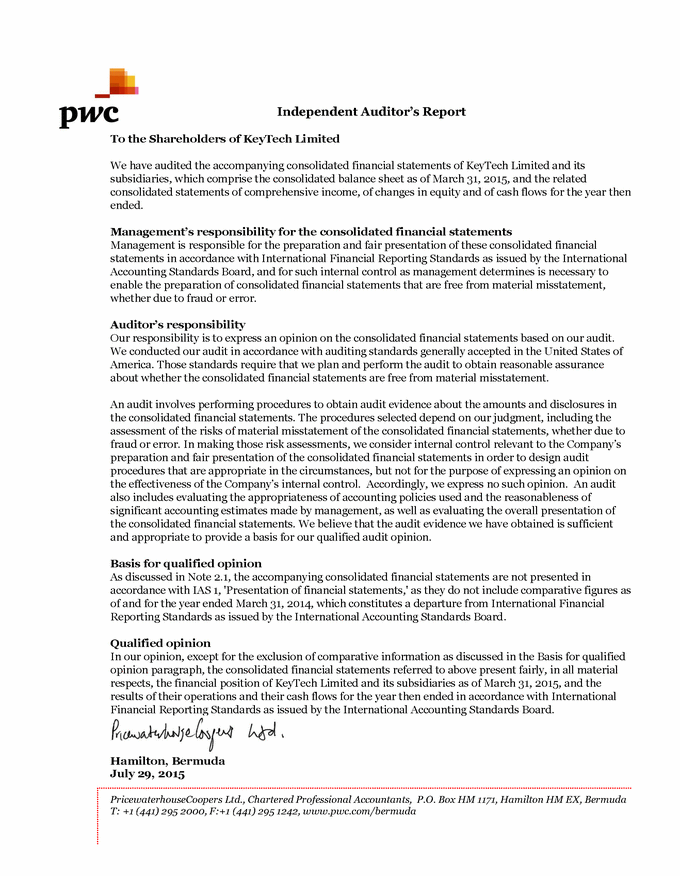
Consolidated Balance Sheet As at March 31, 2015 Notes March 31, 2015 ASSETS Current assets Cash and cash equivalents (excluding bank overdraft) Accounts receivable Materials Prepaid expenses and other current assets Assets held for sale 12 13 14 15 29 $ 3,717,631 8,413,539 33,269 4,014,261 948,471 17,127,171 Non-current assets Available-for-sale financial assets Loan receivable Property, plant and equipment Investments in associates Intangible assets 3.3, 16 28 17 9 18 1,109,546 5,000,000 117,527,905 25,760,775 80,419,866 Total assets $ 246,945,263 LIABILITIES AND SHAREHOLDERS EQUITY Current liabilities Accounts payable and accrued liabilities Bank overdraft Foreign tax liabilities Interest payable Unearned income 19 20 $ 13,547,836 779,450 168,500 522,578 6,099,098 687,116 6,428,571 83,333 Preferred share redemption Loan payable Liabilities held for sale amounts unclaimed 20 20 29 28,316,482 Non-current liabilities Loan payable Sub-ordinated debt 20 20 35,357,143 24,700,000 $ 88,373,625 Total liabilities EQUITY Equity attributable to owners of the parent Share capital Share premium Contributed surplus Shares held for issue Other comprehensive income (loss) Retained earnings 23 3,806,197 86,058,361 20,994,717 7,493,110 14,389,750 18,915,296 23, 26 151,657,431 24 6,914,207 Non-controlling interests Total equity Total liabilities and equity 158,571,638 $ 246,945,263 Approved by the Board of Directors Director Director 2 The accompanying notes are an integral part of these consolidated financial statements Unlocking a World of Connections | | K E Y T E C H ANNUA L R E P O R T 2 0 1 5
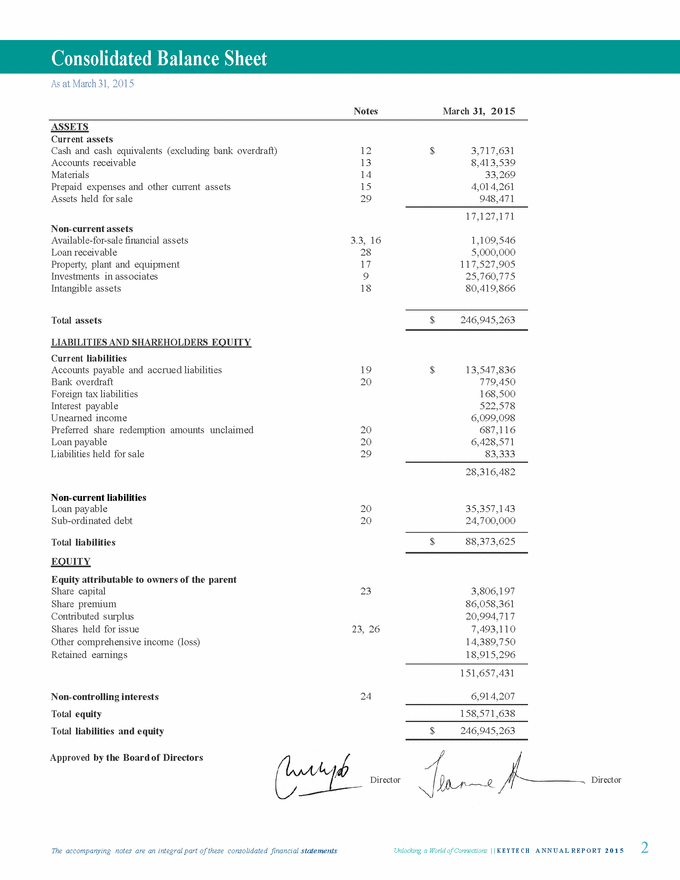
Consolidated Statement of Comprehensive Income For the year ended March 31, 2015 Notes 2015 OPERATING REVENUES Data revenues TV revenues Voice revenues Directory revenues Fixed data revenues Hardware and software revenues Other revenues $ 29,517,695 23,718,598 2,875,605 4,289,745 2,217,600 74,566 4,209,694 5 $ 66,903,503 OPERATING EXPENSES Salaries and employee benefit expenses Staff termination costs Operations and maintenance expenses Depreciation and amortization General and administrative expenses Government taxes, fees and levies 6 6 20,854,821 443,766 26,070,997 15,820,862 13,287,750 3,432,965 17,18 7 8 $ 79,911,161 Operating loss Share of income of associates Finance income Finance costs Loss on disposal of subsidiary Gain on investment Net proceeds on insurance claim Losses on property revaluation Non-controlling interests (13,007,658) 7,135,389 193,050 (3,216,251) (18,617,231) 11,397,492 2,144,352 (2,021,350) 126,554 9 10 10 28 2.22 2.1.1, 17 Loss for the year from continuing operations $ (15,865,653) DISCONTINUED OPERATIONS Profit for the year from discontinued operations Loss for the year 2,626,474 (13,239,179) $ Loss attributable to Equity holders of the company Non-controlling interests (13,112,625) (126,554) $ (13,239,179) Earnings per share from continuing and discontinued operations attributable to owners of the parent From continuing operations From discontinued operations From (loss) profit for the year 11 $ (1.06) 0.18 $ (0.88) 3 The accompanying notes are an integral part of these consolidated financial statements Unlocking a World of Connections | | K E Y T E C H ANNUA L R E P O R T 2 0 1 5
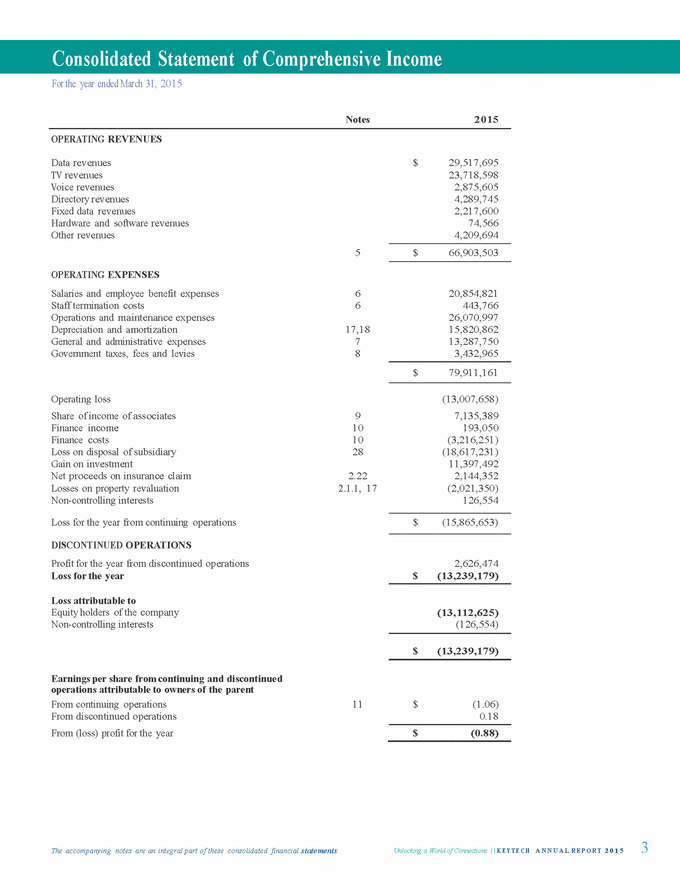
Consolidated Statement of Comprehensive Income (Ccoonnttiinnuueedd)) For the year ended March 31, 2015 Notes 2015 Loss for the year $ (13,239,179) Other comprehensive income (loss) for the year: Discontinued operations Sale of subsidiary – defined benefit pension plan Sale of subsidiary – retirement augmentation plan 22 22 2,620,113 484,081 3,104,194 Items that may be subsequently reclassified to profit or loss Gain on property revaluations 2.1.1, 17 14,010,424 Other comprehensive income for the year $ 17,114,618 Total comprehensive income for the year $ 3,875,439 Total comprehensive income (loss) attributable to: Equity holders of the company Non-controlling interests $ 4,001,993 (126,554) $ 3,875,439 Total comprehensive income (loss) attributable to: Continuing operations Discontinued operations $ (1,855,229) 5,730,668 $ 3,875,439 4 The accompanying notes are an integral part of these consolidated financial statements Unlocking a World of Connections | | K E Y T E C H ANNUA L R E P O R T 2 0 1 5
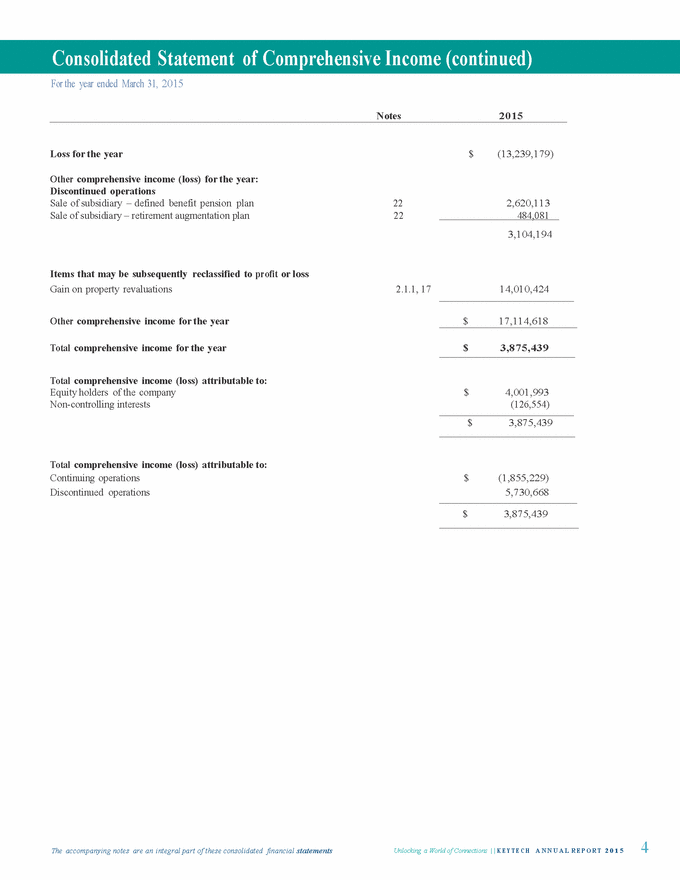
Consolidated Statement of CohmanpgreeshiennEsiqveuiItnycome (Continued) For the year ended March 31, 2015 Shares held for issue Other comprehensive income Non-controlling Interest Share capital Share premium Contributed surplus Retained earnings Notes Total Total Balance - April 1, 2014 Loss for the period Other comprehensive income: Realized profit on valuation 2.1.1, $3,640,908 - $83,413,733 $20,920,454 $(2,724,868) $33,714,417 $138,964,644 534,866 $139,499,510 - - - - - (13,112,625) (13,112,625) (126,554) (13,239,179) - - - - 14,010,424 - 14,010,424 - 14,010,424 of property 17 Sale of subsidiary - defined - - - - 2,620,113 - 2,620,113 - 2,620,113 benefit pension plan Sale of subsidiary - retirement augmentation plan Comprehensive income for the period 22 22 - - - - 484,081 - 484,081 - 484,081 - - - - 17,114,618 17,114,618 17,114,618 Non-controlling interests - - - - - (126,554) (126,554) 6,505,895 6,379,341 Shares issued Shares held for issue Dividends Contribution to equity 23 23, 26 165,289 - - - - 7,493,110 - - 2,644,628 - - - - - - 74,263 - - - - - - (1,559,942) - 2,809,917 7,493,110 (1,559,942) 74,263 - - - - 2,809,917 7,493,110 (1,559,942) 74,261 Balance - March 31, 2015 $3,806,197 $7,493,110 $86,058,361 $20,994,717 $14.389,750 $18,915,296 $151,657,431 $6,914,207 $158,571,638 5 The accompanying notes are an integral part of these consolidated financial statements Unlocking a World of Connections | | K E Y T E C H ANNUA L R E P O R T 2 0 1 5
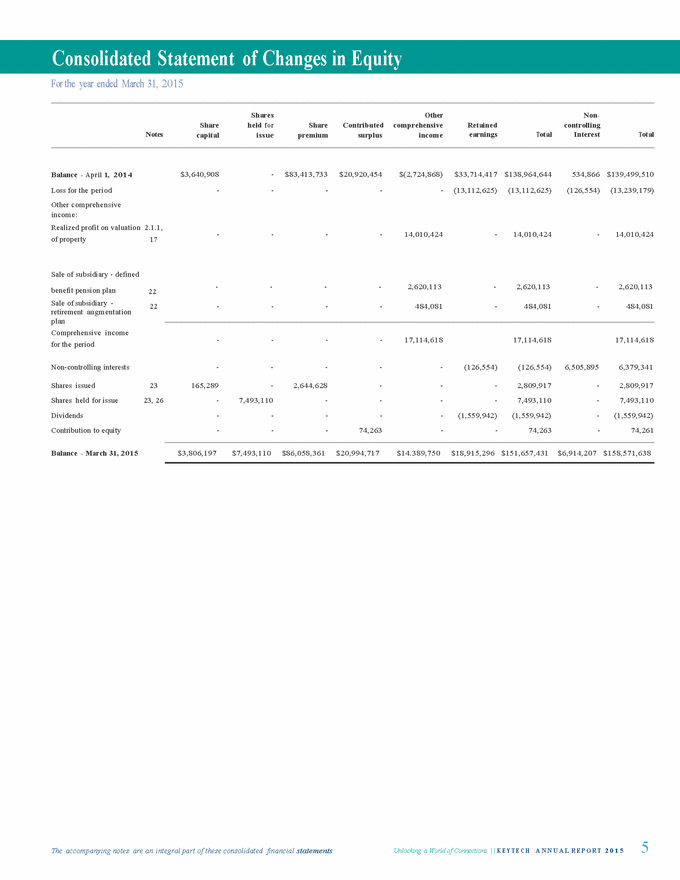
Consolidated Sttatteemenntt of Caasshh FFlloowwss For the year ended March 31, 2015 Notes 2015 CASH FLOW PROVIDED BY (USED IN) Operating activities Loss for the period Adjustments for: Depreciation and amortization Bad debt expenses and impairment allowances Share of income of associates Loss on disposal of subsidiary Gain on investment Loss on property revaluation Profit for the year from discontinued operations Changes in items of working capital: Accounts receivable Materials Prepaid expenses and other current assets Accounts payable and accrued liabilities Foreign tax liabilities Unearned income Working capital acquired on business combinations Net cash generated from discontinued activities Net cash generated from operating activities Investing activities Repayments received on loans to associates Additional investment in associates Dividends received from associates Sale of available-for-sale financial assets Purchase of property, plant and equipment Purchase of intangible assets Property, plant and equipment acquired on business combinations Intangible assets arising on business combinations Goodwill arising on business combinations Net cash from discontinued activities Net cash used for investing activities Financing activities Amount received on borrowing facility Amount repaid on borrowing facility Net amount received as subordinated debt Redemption of preferred shares Dividends paid on common shares Net cash received from financing activities $ (13,239,179) 17,18 13 9 15,820,862 824,487 (7,135,389) 18,617,231 (11,397,492) 2,021,350 (2,626,474) 2,996,166 1,821,041 2,996,911 (2,435,026) (5,908) (2,872,418) 3,129,520 6,297,041 $ 14,812,723 704,983 101,660 5,749,235 342,287 (7,832,172) (1,535,870) (38,657,606) (13,850,270) (23,484,701) 24,780,000 $ (53,682,454) 45,000,000 (30,714,286) 24,700,000 (8,555) (2,871,201) 26 20 21 $ 36,105,958 Decrease in cash and cash equivalents Cash and cash equivalents and bank overdraft - Beginning of year Cash and cash equivalents and bank overdraft - End of year $ (2,763,773) $ 5,701,954 12 $ 2,938,181 6 The accompanying notes are an integral part of these consolidated financial statements Unlocking a World of Connections | | K E Y T E C H ANNUA L R E P O R T 2 0 1 5
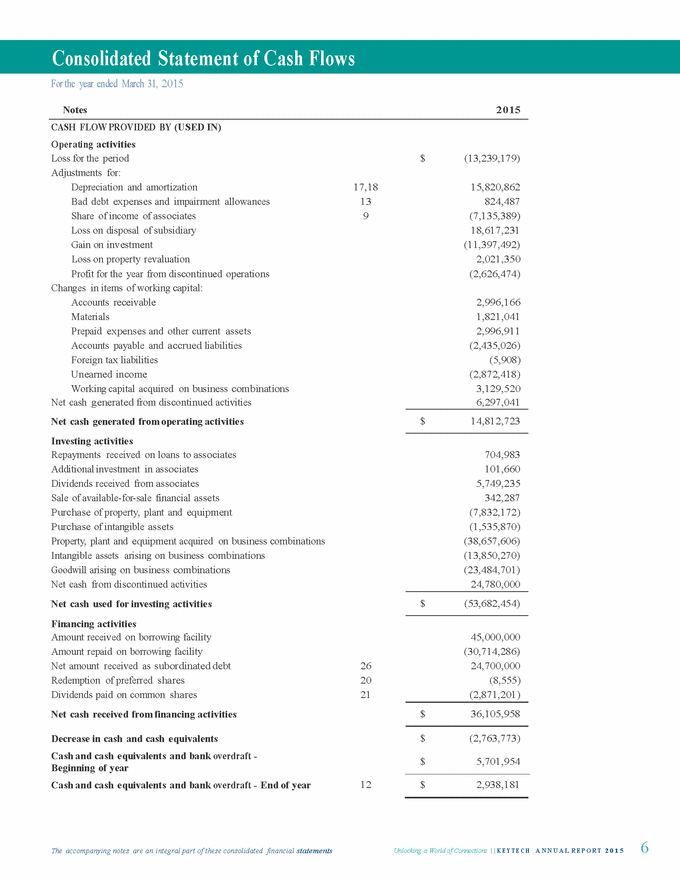
CNontessoltiodaCtoednsSotliadtaetmedenFt inofanCcaiashl SFtlaotwems ents For the year ended March 31, 2015 1. The Company and its regulatory framework KeyTech Limited (the “Company”) is incorporated in Bermuda with limited liability under the Companies Act 1981. The Company, through its subsidiaries and associates, is a supplier of information and communications services, providing a wide range of data, Internet, voice, and media services. The Company is listed on the Bermuda Stock Exchange (“BSX”) and has operations in Bermuda and the Cayman Islands. The registered office is located at 30 Victoria Street, Hamilton, HM 12, Bermuda. These consolidated financial statements were approved by the Directors on July 24, 2015. 2. Summary of significant accounting policies 2.1Basis of preparation The consolidated financial statements of the Company have been prepared in accordance with International Financial Reporting Standards (“IFRS”) and IFRS Interpretations Committee (IFRIC) interpretations applicable to companies reporting under IFRS, except for the exclusion of comparative figures for the prior year required by IAS 1 “Presentation of Financial Statements”. The purpose of these financial statements is to meet the reporting requirements of Rule 3-05 of Regulation S-X of the Securities and Exchange Commission. The consolidated financial statements have been prepared under the historical cost convention, with the exception of land and buildings (see note 2.1.1), available-for-sale financial assets and financial assets and financial liabilities, which are recorded at fair value through profit or loss. The financial statements are presented in Bermuda dollars ($), which is the functional currency of the Company. The preparation of consolidated financial statements in conformity with IFRS requires the use of certain critical accounting estimates. It also requires management to exercise its judgment in the process of applying the Company’s accounting policies. The areas involving a higher degree of judgment or complexity, or areas where assumptions and estimates are significant to the consolidated financial statements are disclosed in note 4. 2.1.1 Changes in accounting policy and disclosures As at March 31, 2015 the Company and its subsidiaries have adopted a policy of revaluing land and buildings to market value, in accordance with the fair value provisions of IAS 16 ‘Property, plant and equipment’. This is a change from the previous policy, under which these assets were stated at historic cost. The revaluation of land and buildings within the Group’s consolidated balance sheet provides shareholders with a more representative value than the historic cost basis. This change in accounting policy has not been applied retrospectively. The impact on the financial statements of this change in accounting policy has been to: • increase the net book value of land by $1,145,849 and buildings by $10,843,225 as at March 31, 2015; • recognize an exceptional charge against operating profit in respect of ‘losses on property revaluation’ of $2,021,350. This impairment reflects the difference for all assets where the fair value of the asset as determined by the revaluation as at March 31, 2015 is below the net book value prior to the revaluation; • recognize an exceptional gain in other comprehensive income of $14,010,424 reflecting the difference for all assets where the fair value of the asset as determined by the revaluation as at March 31, 2015 is above the net book value prior to the revaluation; • the impact of the above is a net increase in the value of land and buildings of $11,989,074 (see note 17). This has been booked as an increase on cost or valuation of $5,580,970 and a write back of accumulated depreciation of $6,408,104; New and amended standards adopted by the Company The following standards have been adopted by the Company for the first time for the financial year beginning April 1, 2014 and have an impact on the Company: 7 Unlocking a World of Connections | | K E Y T E C H ANNUA L R E P O R T 2 0 1 5
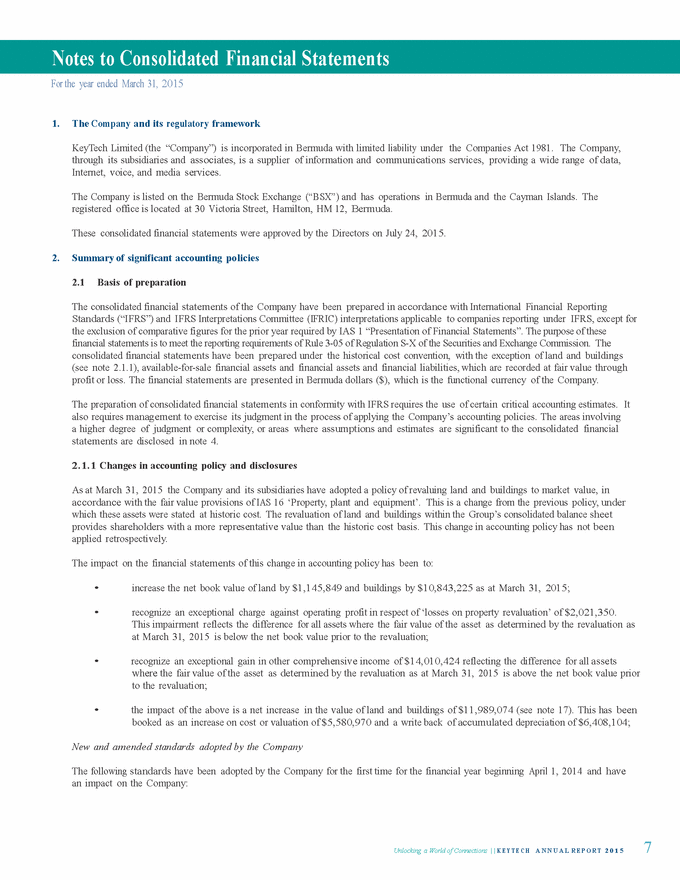
CNontessoltiodaCtoednsSotliadtaetmedenFt inofanCcaiashl SFtlaotwems ents For the year ended March 31, 2015 Amendment to IFRS 8, Operating segments must include disclosure of judgments made by management aggregating segments, and a reconciliation of segment assets when segment assets are reported. Amendment to IAS 24, related party transactions, has been amended to (i) revise definition of ‘related party’ to include an entity that provides key management personnel services to the reporting entity or its parent, and (ii) clarify related disclosure requirements. New standards and interpretations not yet adopted A number of new standards and amendments to standards and interpretations are effective for annual periods beginning after April 1, 2014, and have not been applied in preparing these consolidated financial statements. None of these is expected to have a significant effect on the consolidated financial statements of the Company, except the following set out below: Amendments to IAS 36, ‘Impairment of assets’, on the recoverable amount disclosures for non-financial assets. This amendment removed certain disclosures of the recoverable amount of cash generating units (CGUs) which had been included in IAS 36 by the issue of IFRS 13. The amendment is not mandatory for the Company until April 1, 2016. IFRS 9, ‘Financial instruments’, addresses the classification, measurement and recognition of financial assets and financial liabilities. The IASB issued the completed version of IFRS 9 in July 2014. IFRS 9 (2014) provides revised guidance on the classification and measurement of financial assets and introduces a new expected credit loss model for calculating impairment. IFRS 9 (2014) also incorporates the final general hedge accounting requirements originally published in IFRS 9 (2013). IFRS 9 (2014) is effective for the reporting period beginning on April 1, 2018. IFRS 15, ‘Revenue from contracts with customers’, was issued in May 2014 by the IASB and FASB, a converged standard on revenue recognition. The standard will be effective for the reporting period beginning on April 1, 2017, and will allow early adoption. The standard will improve the financial reporting of revenue and improve comparability of the top line in the financial statements globally. The Company is yet to assess the full impact of IFRS 15 and intends to adopt the standard no later than the accounting period beginning on April 1, 2017. There are no other IFRSs or IFRIC interpretations that are not yet effective that would be expected to have a material impact on the Company. 2.2 Consolidation (a) Subsidiaries Subsidiaries are all entities over which the Company has control. The Company controls an entity when the Company is exposed to, or has rights to, variable returns from its involvement with the entity and has the ability to affect those returns through its power over the entity. Subsidiaries are fully consolidated from the date on which control is transferred to the Company. They are deconsolidated from the date that control ceases. The Company applies the acquisition method to account for business combinations. The consideration transferred for the acquisition of a subsidiary is the fair values of the assets transferred, the liabilities incurred to the former owners of the acquiree and the equity interests issued by the Company. The consideration transferred includes the fair value of any asset or liability resulting from a contingent consideration arrangement. Identifiable assets acquired and liabilities and contingent liabilities assumed in a business combination are measured initially at their fair values at the acquisition date. The Company recognizes any non-controlling interest in the acquiree on an acquisition-by-acquisition basis, either at fair value or at the non-controlling interest’s proportionate share of the recognized amounts of acquiree’s identifiable net assets. Acquisition-related costs are expensed as incurred. If the business combination is achieved in stages, the acquisition date carrying value of the acquirer’s previously held equity interest in the acquiree is re-measured to fair value at the acquisition date; any gains or losses arising from such re-measurement are recognized in profit or loss. 8 Unlocking a World of Connections | | K E Y T E C H ANNUA L R E P O R T 2 0 1 5
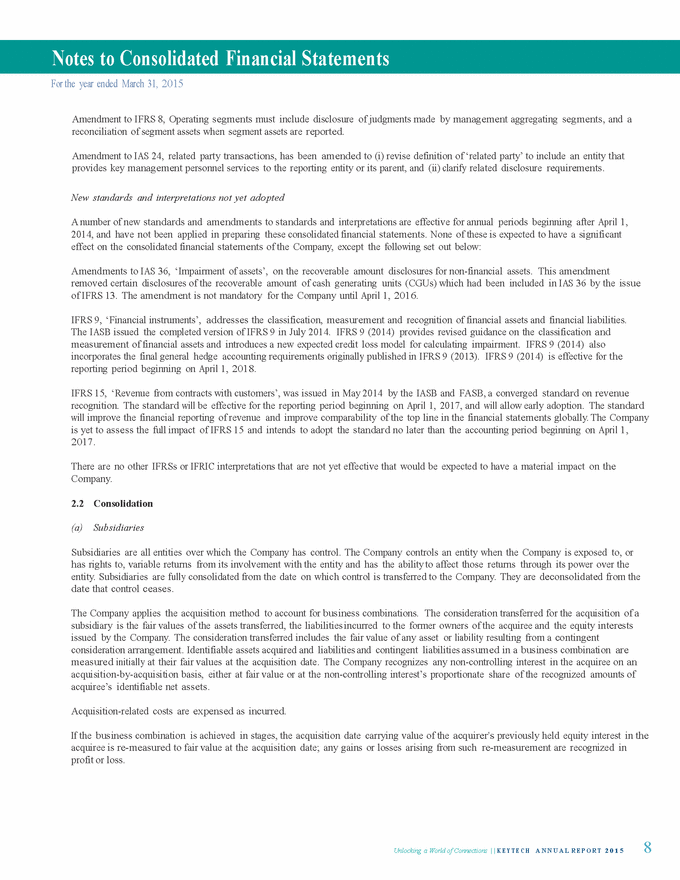
CNontessoltiodaCtoednsSotliadtaetmedenFt inofanCcaiashl SFtlaotwems ents For the year ended March 31, 2015 Any contingent consideration to be transferred by the Company is recognized at fair value at the acquisition date. Subsequent changes to the fair value of the contingent consideration that is deemed to be an asset or liability is recognized in accordance with IAS 39 either in profit or loss or as a change to other comprehensive income. Contingent consideration that is classified as equity is not re-measured, and its subsequent settlement is accounted for within equity. The excess of the consideration transferred, the amount of any non-controlling interest in the acquiree and the acquisition-date fair value of any previous equity interest in the acquiree over the fair value of the identifiable net assets acquired, is recorded as goodwill. If the total of consideration transferred, non-controlling interest recognized and previously held interest measured is less than the fair value of the net assets of the subsidiary acquired in the case of a bargain purchase, the difference is recognized directly in the income statement. Intercompany transactions, balances, income and expenses on transactions between subsidiaries are eliminated. Profits and losses resulting from intercompany transactions that are recognized in assets are also eliminated. Accounting policies of subsidiaries have been changed where necessary to ensure consistency with the policies adopted by the Company. The consolidated financial statements include the financial statements of the Company and its wholly owned subsidiaries: Logic Communications Ltd. (“Logic”), WestTel Limited (trading as Logic) (“Logic Cayman”), Bermuda Yellow Pages Limited (“BYP”), Key Management Services Limited (“KMS”), Cable Co. Ltd. (“Cable”) and Cedar Cable Ltd. (“Cedar”), (jointly “Cable Co.”). The consolidated financial statements include the Company’s interest in Cablevision Holdings Limited (“CHL”) and its subsidiary Bermuda Cablevision Limited (“BCL”) from September 3, 2014, whereby the Company has an 84.6% interest (prior to this is was included in investments in associates), and Yabsta (BVI) Limited (“Yabsta”), whereby the Company has a 51% interest. The Company’s previous 100% interest in The Bermuda Telephone Company Limited (“BTC”) is classified as a discontinued operation following its disposal on September 3, 2015, see note 28. (b) Changes in ownership interests in subsidiaries without change of control Transactions with non-controlling interests that do not result in loss of control are accounted for as equity transactions – that is, as transactions with the owners in their capacity as owners. The difference between fair value of any consideration paid and the relevant share acquired of the carrying value of net assets of the subsidiary is recorded in equity. Gains or losses on disposals to non-controlling interests are also recorded in equity. (c) Disposal of subsidiaries When the Company ceases to have control any retained interest in the entity is re-measured to its fair value at the date when control is lost, with the change in carrying amount recognized in profit or loss. The fair value is the initial carrying amount for the purposes of subsequently accounting for the retained interest as an associate, joint venture or financial asset. In addition, any amounts previously recognized in other comprehensive income in respect of that entity are accounted for as if the Company had directly disposed of the related assets or liabilities. This may mean that amounts previously recognized in other comprehensive income are reclassified to profit or loss. (d) Associates Associates are all entities over which the Company has significant influence but not control, generally accompanying a shareholding of between 20% and 50% of the voting rights. Investments in associates are accounted for using the equity method of accounting. Under the equity method, the investment is initially recognized at cost, and the carrying amount is increased or decreased to recognize the investor’s share of the profit or loss of the investee after the date of acquisition. The Company’s investment in associates includes goodwill identified on acquisition. If the ownership interest in an associate is reduced but significant influence is retained, only a proportionate share of the amounts previously recognized in other comprehensive income is reclassified to profit or loss where appropriate. The Company’s share of post-acquisition profit or loss is recognized in the income statement, and its share of post-acquisition movements in other comprehensive income is recognized in other comprehensive income with a corresponding adjustment to the carrying amount of the investment. When the Company’s share of losses in an associate equals or exceeds its interest in the associate, including any other unsecured receivables, the Company does not recognize further losses, unless it has incurred legal or constructive obligations or made payments on behalf of the associate. 9 Unlocking a World of Connections | | K E Y T E C H ANNUA L R E P O R T 2 0 1 5
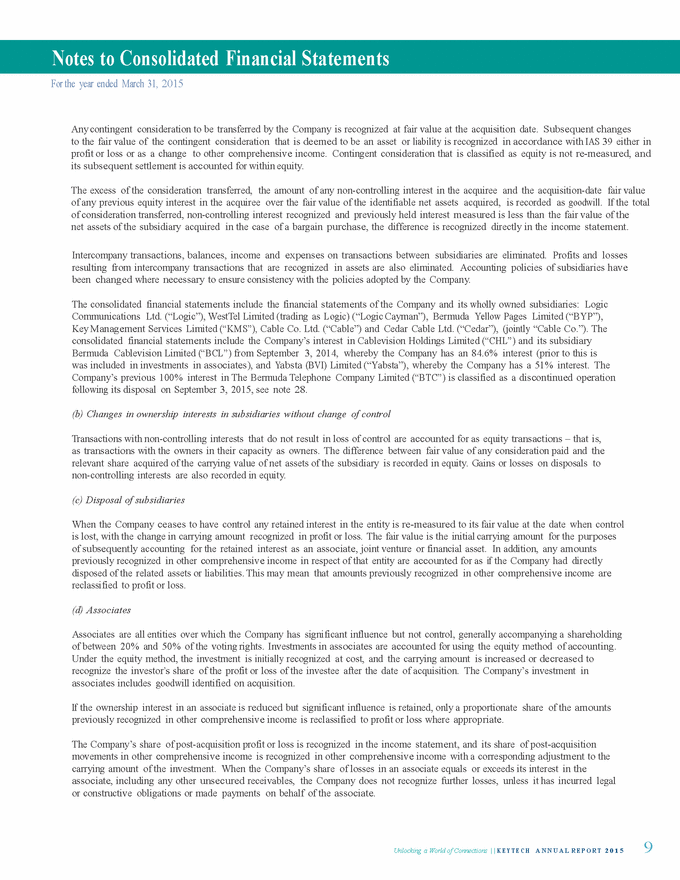
CNontessoltiodaCtoednsSotliadtaetmedenFt inofanCcaiashl SFtlaotwems ents For the year ended March 31, 2015 The Company determines at each reporting date whether there is any objective evidence that the investment in the associate is impaired. If this is the case, the Company calculates the amount of impairment as the difference between the recoverable amount of the associate and its carrying value and recognizes the amount adjacent to ‘share of profit / (loss) of associates in the income statement. Profits and losses resulting from upstream and downstream transactions between the Company and its associate are recognized in the Company’s financial statements only to the extent of unrelated investor’s interests in the associates. Unrealized losses are eliminated unless the transaction provides evidence of an impairment of the asset transferred. Accounting policies of associates have been changed where necessary to ensure consistency with the policies adopted by the Company. Dilution gains and losses arising in investments in associates are recognized in the income statement. 2.3 Segment reporting Operating segments are reported in a manner consistent with the internal reporting provided to the chief operating decision-maker. The chief operating decision-maker, who is responsible for allocating resources and assessing performance of the operating segments, has been identified as the Chief Executive Officer, Chief Financial Officer and members of the Board of Directors, who make decisions about resources to be allocated to the segment and assess its performance. Refer to note 5. 2.4 Foreign currency translation (a) Functional and presentation currency Items included in the financial statements of each of the Company’s entities are measured using the currency of the primary economic environment in which the entity operates (‘the functional currency’). The consolidated financial statements are presented in Bermuda dollars (BMD), which is the Company’s presentation currency. (b) Transactions and balances Foreign currency transactions are translated into the functional currency using the exchange rates prevailing at the dates of those transactions or valuation where items are re-measured. Monetary assets and liabilities denominated in foreign currencies at the reporting date are translated to BMD at the rates of exchange ruling on that date. Gains and losses arising from fluctuations in exchange rates are recognized in the consolidated statement of comprehensive income. Foreign currency losses for the year ended March 31, 2015 were $35,661. Non-monetary assets and liabilities denominated in foreign currencies that are stated at fair value and are translated to BMD at foreign exchange rates ruling at the dates the values were determined. For the purpose of the statement of cash flows, all foreign currency gains and losses recognized in the consolidated statement of comprehensive income are treated as cash items and included in cash flows from operating or financing activities along with movements in the relevant balances. 2.5 Property, plant and equipment Land and buildings comprise mainly offices and network facilities. Land and buildings are shown at fair value, based on valuations by external independent valuers, less subsequent depreciation for buildings. Valuations are performed with sufficient regularity to ensure that the fair value of a revalued asset does not differ materially from its carrying amount. Any accumulated depreciation at the date of revaluation is eliminated against the gross carrying amount of the asset, and the net amount is restated to the revalued amount of the asset. All other property, plant and equipment is stated at historical cost less depreciation. Historical cost includes expenditure that is directly attributable to the acquisition of the items. Cost may also include transfers from equity of any gains/losses on qualifying cash flow hedges of foreign currency purchases of property, plant and equipment. Subsequent costs are included in the asset’s carrying amount or recognized as a separate asset, as appropriate, only when it is probable that future economic benefits associated with the item will flow to the Company and the cost of the item can be measured reliably. The carrying amount of the replaced part is derecognized. All other repairs and maintenance are charged to the income statement during the financial period in which they are incurred. 10 Unlocking a World of Connections | | K E Y T E C H ANNUA L R E P O R T 2 0 1 5
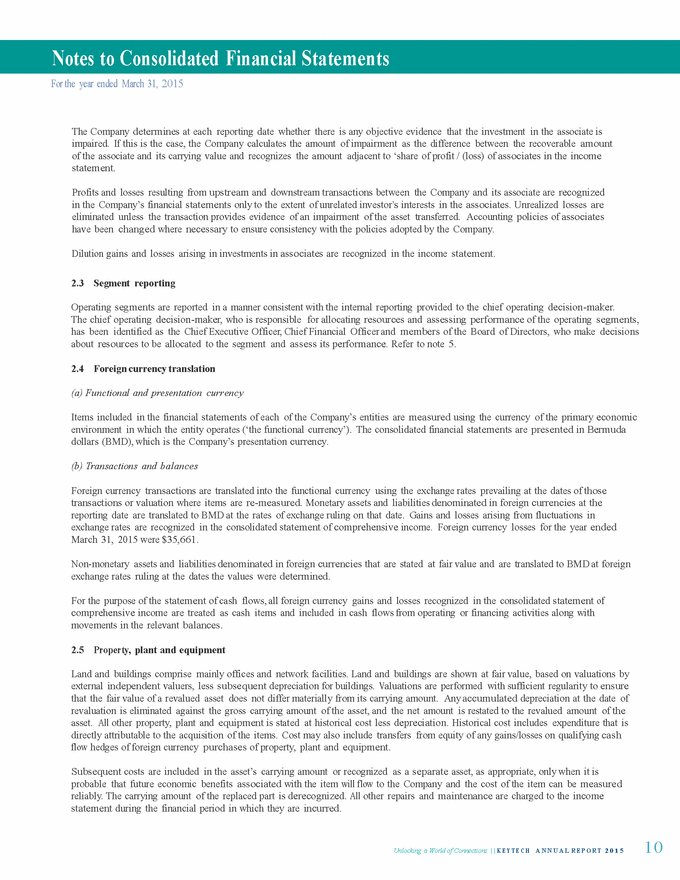
CNontessoltiodaCtoednsSotliadtaetmedenFt inofanCcaiashl SFtlaotwems ents For the year ended March 31, 2015 Costs incurred relating to plant under construction are capitalized and held unamortized within “plant under construction” until such time as the asset is substantially complete, at which time the asset is commissioned and amortized over its useful life. Land is not depreciated. Depreciation on other assets is calculated using the straight-line method to allocate their cost or revalued amounts to their residual values over their estimated useful lives, as follows: Buildings Buildings leased under capital lease Fixtures Plant and facilities Submarine cable system Machinery and equipment 40 - 50 years 50 years (or lease term if shorter) 5 – 15 years 4 – 20 years 15 years 3 – 14 years The assets’ residual values and useful lives are reviewed, and adjusted if appropriate, at the end of each reporting period. An asset’s carrying amount is written down immediately to its recoverable amount if the asset’s carrying amount is greater than its estimated recoverable amount (note 2.7). Gains and losses on disposals are determined by comparing the proceeds with the carrying amount and are recognized within ‘Other (losses) / gains – net’ in the income statement, which is Nil for the fiscal year ended 2015. 2.6 Intangible assets (a) Goodwill Goodwill arises on the acquisition of subsidiaries and represents the excess of the consideration transferred, over KeyTech Limited’s interest in the fair value of the identifiable net assets, liabilities, the amount of any non-controlling interest in the acquiree and the acquisition date fair value of any previous equity interest in the acquiree. For the purpose of impairment testing, goodwill acquired in a business combination is allocated to each of the cash generating units (CGUs), or groups of CGUs, that is expected to benefit from the synergies of the combination. Each unit or group of units to which the goodwill is allocated represents the lowest level within the entity at which the goodwill is monitored for internal management purposes. Goodwill is monitored at the operating segment level. Goodwill impairment reviews are undertaken annually or more frequently if events or changes in circumstances indicate a potential impairment. The carrying value of goodwill is compared to the recoverable amount, which is the higher of value in use and the fair value less costs to sell. Any impairment is recognized immediately as an expense and is not subsequently reversed. (b) Indefeasible right of use (IRU) IRUs are initially recorded at cost and amortized over the useful economic life to the estimated residual value and reviewed for impairment when indications of impairment exist. Any permanent impairment of the value is charged to earnings in the year the impairment is recognized. IRUs have finite useful lives and are carried at cost less accumulated amortization. Amortization is calculated using the straight-line method to allocate the cost of the IRU over the estimated useful life, which is 10 – 15 years. (c)Computer software Costs associated with maintaining computer software programs are recognized as an expense as incurred. Development costs that are directly attributable to the design and testing of identifiable and unique software products controlled by the Company are recognized as intangible assets when the following criteria are met: • • • • • it is technically feasible to complete the software product so that it will be available for use; management intends to complete the software product and use or sell it; there is an ability to use or sell the software product; it can be demonstrated how the software product will generate probable future economic benefits; adequate technical, financial and other resources to complete the development and to use or sell the software product are available; and the expenditure attributable to the software product during its development can be reliably measured. • 11 Unlocking a World of Connections | | K E Y T E C H ANNUA L R E P O R T 2 0 1 5
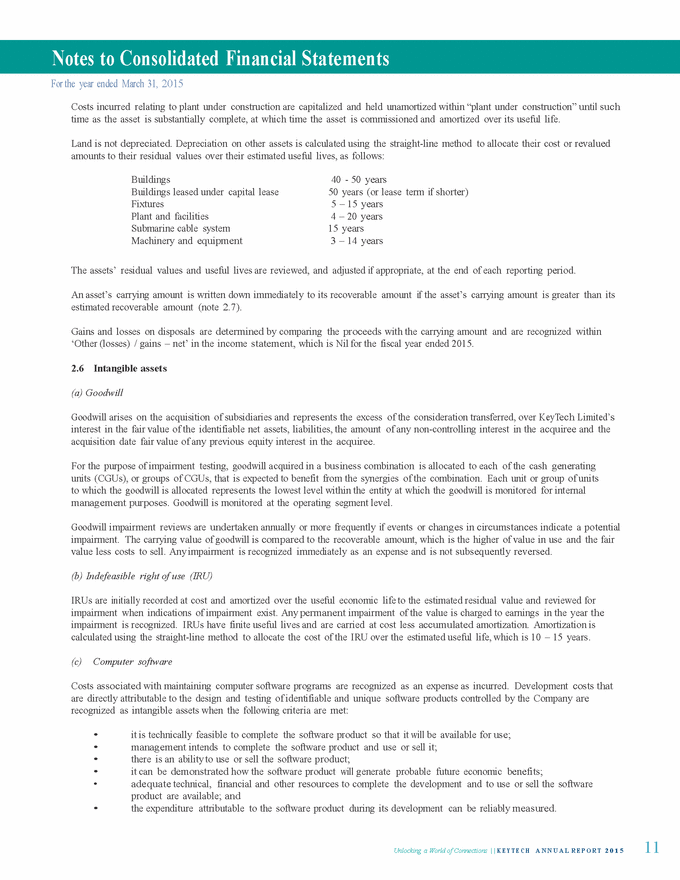
CNontessoltiodaCtoednsSotliadtaetmedenFt inofanCcaiashl SFtlaotwems ents For the year ended March 31, 2015 Directly attributable costs that are capitalized as part of the software product include the software development employee costs and an appropriate portion of relevant overheads. Other development expenditures that do not meet these criteria are recognized as an expense as incurred. Development costs previously recognized as an expense are not recognized as an asset in a subsequent period. Computer software development costs recognized as assets are amortized over their estimated useful lives, which does not exceed 15 years. 2.7 Impairment of non-financial assets Assets that have an indefinite useful life – for example, goodwill or intangible assets not ready to use – are not subject to amortization and are tested annually for impairment. Assets that are subject to amortization are reviewed for impairment whenever events or changes in circumstances indicate that the carrying amount may not be recoverable. An impairment loss is recognized for the amount by which the asset’s carrying amount exceeds its recoverable amount. The recoverable amount is the higher of an asset’s fair value less costs to sell and value in use. For the purposes of assessing impairment, assets are grouped at the lowest levels for which there are separately identifiable cash flows (cash-generating units). Prior impairments of non-financial assets (other than goodwill) are reviewed for possible reversal at each reporting date. 2.8 Non-current assets (or disposal groups) held for sale Non-current assets (or disposal groups) are classified as assets held for sale when their carrying amount is to be recovered principally through a sale transaction and a sale is considered highly probable. They are stated at the lower of carrying amount and fair value less costs to sell. 2.9 Financial assets 2.9.1 Classification The Company classifies its financial assets in the following categories: loans and receivables, and available for sale. The classification depends on the purpose for which the financial assets were acquired. Management determines the classification of its financial assets at initial recognition. (a) Loans and receivables Loans and receivables are non-derivative financial assets with fixed or determinable payments that are not quoted in an active market. They are included in current assets, except for maturities greater than 12 months after the end of the reporting period. These are classified as non-current assets. The Company’s loans and receivables comprise ‘accounts receivable, ‘loan receivable’ and ‘cash and cash equivalents’ in the balance sheet (notes 2.14 and 2.15). (b) Available-for-sale financial assets Available-for-sale financial assets are non-derivatives that are either designated in this category or not classified in any of the other categories. They are included in non-current assets unless the investment matures or management intends to dispose of it within 12 months of the end of the reporting period. The Company’s available-for-sale financial assets comprise marketable securities. 2.9.2 Recognition and measurement Regular purchases and sales of financial assets are recognized on the trade-date – the date on which the Company commits to purchase or sell the asset. Investments are initially recognized at fair value plus transaction costs for all financial assets not carried at fair value through profit or loss. Financial assets are derecognized when the rights to receive cash flows from the investments have expired or have been transferred and the Company has transferred substantially all risks and rewards of ownership. Available-for-sale financial assets are subsequently carried at fair value. Loans and receivables are subsequently carried at amortized cost using the effective interest method. 12 Unlocking a World of Connections | | K E Y T E C H ANNUA L R E P O R T 2 0 1 5
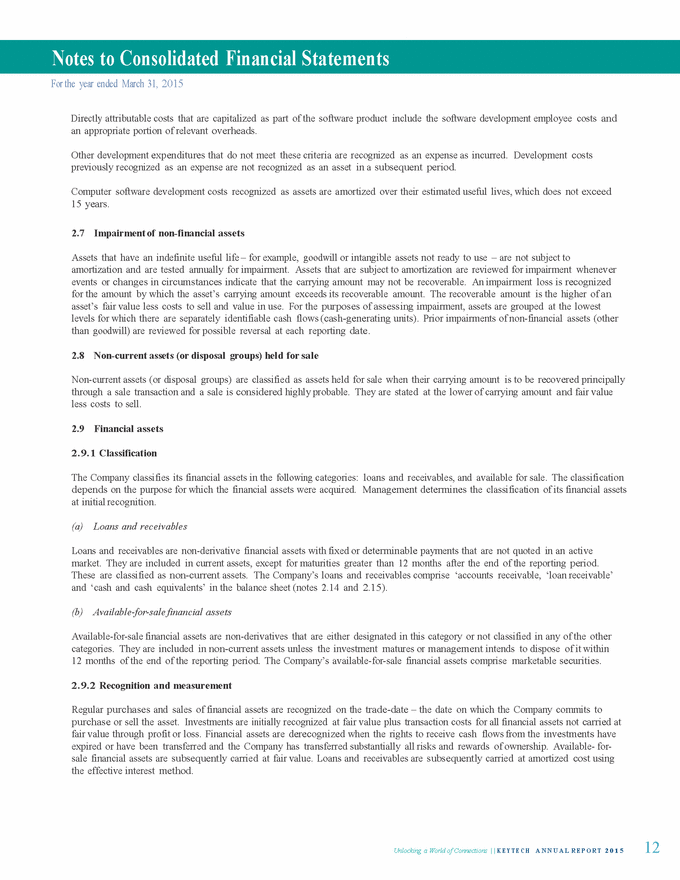
CNontessoltiodaCtoednsSotliadtaetmedenFt inofanCcaiashl SFtlaotwems ents For the year ended March 31, 2015 Gains or losses arising from changes in the fair value of the ‘financial assets at fair value through profit or loss’ category are presented in the consolidated statement of comprehensive income within investment income in the period in which they arise. Dividend income from financial assets at fair value through profit or loss is recognized in the consolidated statement of comprehensive income within investment income when the Company’s right to receive payments is established. Changes in the fair value of monetary and non-monetary securities classified as available for sale are recognized in other comprehensive income. When securities classified as available-for-sale are sold or impaired, the accumulated fair value adjustments recognized in other comprehensive income are included in the statement of comprehensive income as ‘finance income’. Interest on available-for-sale securities calculated using the effective interest method is recognized in the statement of comprehensive income as part of investment income. Dividends on available-for-sale equity instruments are recognized in the statement of comprehensive income as part of investment income when the Company’s right to receive payments is established. 2.10 Offsetting financial instruments Financial assets and liabilities are offset and the net amount reported in the balance sheet when there is a legally enforceable right to offset the recognized amounts and there is an intention to settle on a net basis or realize the asset and settle the liability simultaneously. 2.11 Impairment of financial assets (a) Assets carried at amortized cost The Company assesses at the end of each reporting period whether there is objective evidence that a financial asset is impaired. A financial asset is impaired and impairment losses are incurred only if there is objective evidence of impairment as a result of one or more events that occurred after the initial recognition of the asset (a ‘loss event’) and that loss event (or events) has an impact on the estimated future cash flows of the financial asset that can be reliably estimated. Evidence of impairment may include indications that the debtors or a Company of debtors is experiencing significant financial difficulty, default or delinquency in interest or principal payments, the probability that they will enter bankruptcy or other financial reorganization, and where observable data indicate that there is a measurable decrease in the estimated future cash flows, such as changes in arrears or economic conditions that correlate with defaults. For loans and receivables category, the amount of the loss is measured as the difference between the asset’s carrying amount and the present value of estimated future cash flows (excluding future credit losses that have not been incurred) discounted at the financial asset’s original effective interest rate. The carrying amount of the asset is reduced and the amount of the loss is recognized in the consolidated statement of comprehensive income. If a loan has a variable interest rate, the discount rate for measuring any impairment loss is the current effective interest rate determined under the contract. As a practical expedient, the Company may measure impairment on the basis of an instrument’s fair value using an observable market price. If, in a subsequent period, the amount of the impairment loss decreases and the decrease can be related objectively to an event occurring after the impairment was recognized (such as an improvement in the debtor’s credit rating), the reversal of the previously recognized impairment loss is recognized in the consolidated statement of comprehensive income. (b) Assets classified as available-for-sale The Company assesses at the end of each reporting period whether there is objective evidence that a financial asset or a group of financial assets is impaired. For debt securities, the Company uses the criteria referred to in (a) above. In the case of equity investments classified as available-for-sale, a significant or prolonged decline in the fair value of the security below its cost is also evidence that the assets are impaired. If any such evidence exists for available-for-sale financial assets, the cumulative loss – measured as the difference between the acquisition cost and the current fair value, less any impairment loss on that financial asset previously recognized in profit or loss – is removed from equity and recognized in profit or loss. Impairment losses recognized in consolidated income statement on equity instruments are not reversed through the consolidated income statement. 13 Unlocking a World of Connections | | K E Y T E C H ANNUA L R E P O R T 2 0 1 5
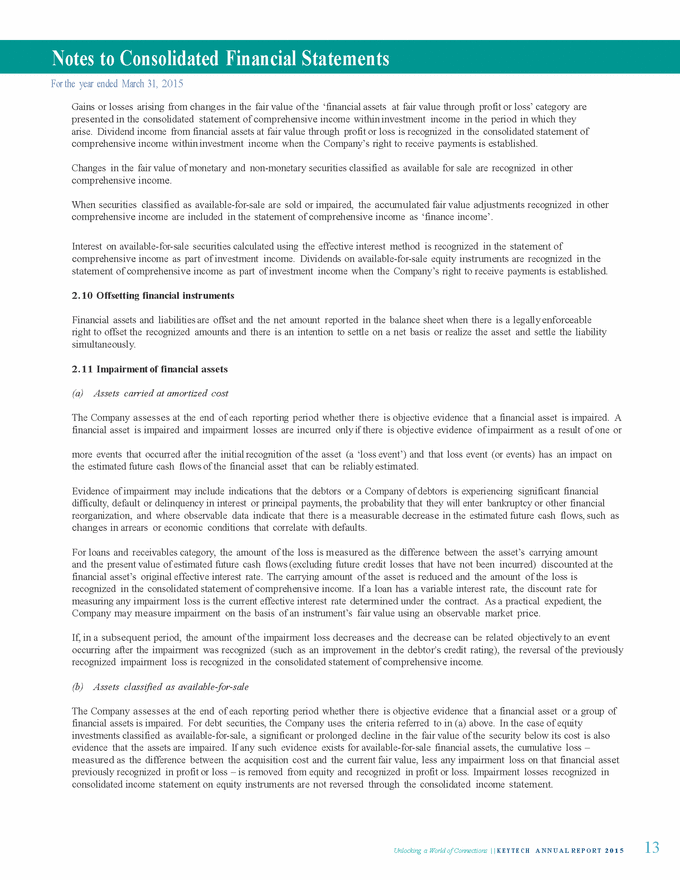
CNontessoltiodaCtoednsSotliadtaetmedenFt inofanCcaiashl SFtlaotwems ents For the year ended March 31, 2015 If, in a subsequent period, the fair value of a debt instrument classified as available-for-sale increases and the increase can be objectively related to an event occurring after the impairment loss was recognized in profit or loss, the impairment loss is reversed through the consolidated statement of comprehensive income. 2.12 Deferred costs Costs incurred directly relating to the publication of the annual directory are deferred and recognized as expenses at the date of publication. Deferred production costs of $1,918,938 are included in prepaid expenses and other current assets in the consolidated balance sheet. Refer to note 15. 2.13 Materials Materials, consisting of items held for resale and parts and consumables, are recorded at lower of average cost and estimated net realizable value. 2.14 Accounts receivable Accounts receivable are amounts due from customers for merchandise sold or services performed in the ordinary course of business. If collection is expected in one year or less, they are classified as current assets. If not, they are presented as non-current assets. Accounts receivable are recognized initially at fair value and subsequently measured at amortized cost using the effective interest method, less provision for impairment. 2.15 Cash and cash equivalents In the consolidated statement of cash flows, cash and cash equivalents includes cash in hand, deposit held at call with banks, other short-term highly liquid investments with original maturities of three months or less and bank overdrafts. In the consolidated balance sheet, bank overdrafts are shown on the face of the consolidated balance sheet in current liabilities. 2.16 Share capital Ordinary shares are classified as equity. Mandatorily redeemable preference shares, which have been redeemed, are classified as liabilities. Incremental costs directly attributable to the issue of new ordinary shares or options are shown in equity as a deduction from the proceeds. Where any company subsidiary purchases the Company’s equity share capital (treasury shares), the consideration paid, including any directly attributable incremental costs is deducted from equity attributable to the Company’s equity holders until the shares are cancelled or reissued. Where such ordinary shares are subsequently reissued, any consideration received, net of any directly attributable incremental transaction costs, is included in equity attributable to the Company’s equity holders. 2.17 Accounts payable Accounts payable are obligations to pay for goods or services that have been acquired in the ordinary course of business from suppliers. Accounts payable are classified as current liabilities if payment is due within one year or less. If not, they are presented as non-current liabilities. Accounts payable and other payables are initially measured at fair value and subsequently carried at amortized cost. They are classified as other liabilities at amortized cost. 2.18 Borrowings Borrowings are recognized initially at fair value, net of transaction costs incurred. Borrowings are subsequently carried at amortized cost; any difference between the proceeds (net of transaction costs) and the redemption value is recognized in the consolidated statement of comprehensive income over the period of the borrowings using the effective interest method. 14 Unlocking a World of Connections | | K E Y T E C H ANNUA L R E P O R T 2 0 1 5
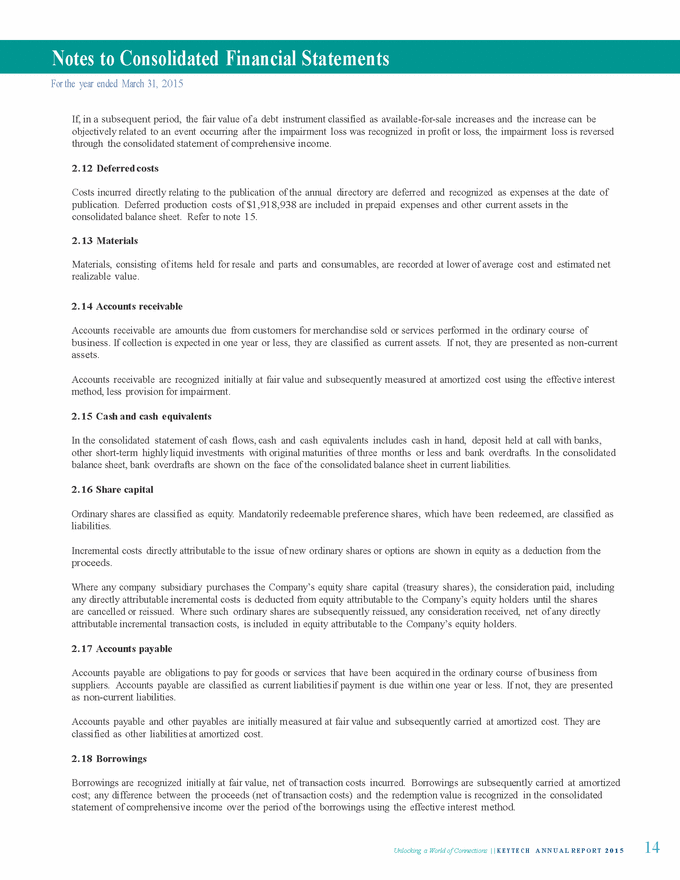
CNontessoltiodaCtoednsSotliadtaetmedenFt inofanCcaiashl SFtlaotwems ents For the year ended March 31, 2015 Fees paid on the establishment of loan facilities are recognized as transaction costs of the loan to the extent that it is probable that some or all of the facility will be drawn down. In this case, the fee is deferred until the draw-down occurs. To the extent there is no evidence that it is probable that some or all of the facility will be drawn down, the fee is capitalized as a pre-payment for liquidity services and amortized over the period of the facility to which it relates. Preference shares, which are mandatorily redeemable on a specific date, are classified as liabilities. 2.19 Borrowing costs Borrowing costs are recognized in profit or loss in the period in which they are incurred. 2.20 Employee benefits The pension and retirement plan and other post-employment obligations relating to BTC retirees was disposed of as part of the sale of BTC during the year ended March 31, 2015. Employee benefits, comprising net pension liabilities included in these financial statements, have been actuarially determined by a qualified independent actuary, appointed by management. The retirement augmentation obligation was a fixed financial stipend to retirees which would increase with general inflation. The expected costs of these benefits were accrued over the period of employment using the same accounting methodology as used for defined benefit pension plans. Actuarial gains and losses arising from experience adjustments and changes in actuarial assumptions were charged or credited to equity in other comprehensive income in the period in which they arose. These obligations were valued annually by independent qualified actuaries. 2.21 Provisions Provisions for environmental restoration, restructuring costs and legal claims are recognized when: the Company has a present legal or constructive obligation as a result of past events; it is probable that an outflow of resources will be required to settle the obligation; and the amount has been reliably estimated. Restructuring provisions comprise employee termination payments. Provisions are not recognized for future operating losses. Where there are a number of similar obligations, the likelihood that an outflow will be required in settlement is determined by considering the class of obligations as a whole. A provision is recognized even if the likelihood of an outflow with respect to any one item included in the same class of obligations may be small. Provisions are measured at the present value of the expenditures expected to be required to settle the obligation using a rate that reflects current market assessments of the time value of money and the risks specific to the obligation. The increase in the provision due to passage of time is recognized as interest expense. 2.22 Revenue recognition The Company recognizes revenues as it provides services or delivers products to customers. Billings for telecommunications services (including fixed line, broadband and internet access billings) are made on a monthly basis. Unbilled revenues from the billing cycle date to the end of each month are recognized as revenue during the month the service is provided. Revenue is deferred in respect of the portion of fixed monthly charges that have been billed in advance. Revenue from installations and connections are recognized upon completion of the installation or connection. Revenue from equipment sales is recognized upon delivery of equipment to the customer. Where multiple products or services are bundled together on sale, revenue is allocated to each element in proportion to its fair value and recognized as appropriate for that element. Revenue is recognized to the extent that it is not contingent on the provision or delivery of a future service. Amounts received in advance of publication of the annual telephone directory for advertising sold are shown as unearned income in the consolidated balance sheet and are recognized as income at the date of publication. Revenues and expenses related to the Internet directory services are recognized on a pro rata basis over the life of the contract. 15 Unlocking a World of Connections | | K E Y T E C H ANNUA L R E P O R T 2 0 1 5
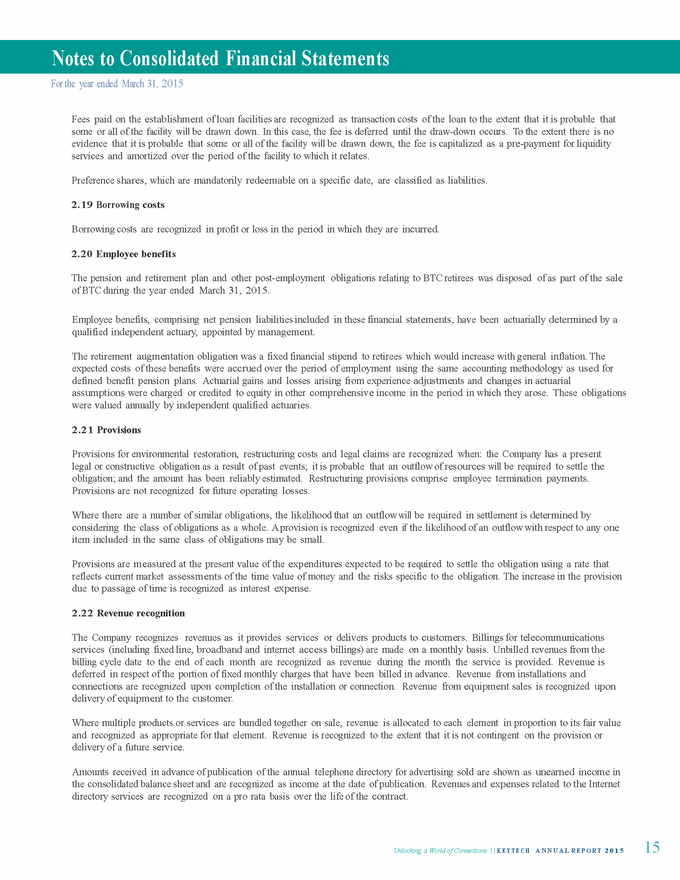
CNontessoltiodaCtoednsSotliadtaetmedenFt inofanCcaiashl SFtlaotwems ents For the year ended March 31, 2015 Revenue for other services is generally recognized as services are performed. During the year BCL made an insurance claim for damage suffered from hurricane Gonzalo, totalling $3.5m after deductible, with associated costs in respect of impaired and diminished assets and other costs of $1.4m. Remaining assets totalling $2.5m with a diminished useful life will be recognized through adjusted useful life. 2.23 Interest income Interest income is recognized using the effective interest method. When a loan and receivable is impaired, the Company reduces the carrying amount to its recoverable amount, being the estimated future cash flow discounted at the original effective interest rate of the instrument, and continues unwinding the discount as interest income. Interest income on impaired loan and receivables is recognized using the original effective interest rate. 2.24 Dividend income Dividend income is recognized when the right to receive payment is established. 2.25 Leases Leases in which a significant portion of the risks and rewards of ownership are retained by the lessor are classified as operating leases. Payments made under operating leases (net of any incentives received from the lessor) are charged to the statement of comprehensive income on a straight-line basis over the period of the lease. The Company leases certain property, plant and equipment. Leases of property, plant and equipment, where the Company has substantially all the risks and rewards of ownership, are classified as finance leases. Finance leases are capitalized at the lease’s commencement at the lower of the fair value of the leased property and the present value of the minimum lease payments. Each lease payment is allocated between the liability and finance charges. The corresponding rental obligations, net of finance charges, are included in other long-term payables. The interest element of the finance cost is charged to the statement of comprehensive income over the lease period so as to produce a constant periodic rate of interest on the remaining balance of the liability for each period. The property, plant and equipment acquired under finance leases is depreciated over the shorter of the useful life of the asset and the lease term. 2.26 Dividend distribution Dividend distribution to the Company’s shareholders is recognized as a liability in the Company’s financial statements in the period in which the dividends are approved by the Company’s Board of Director’s. 2.27 Exceptional items Exceptional items are disclosed separately in the financial statements where it is necessary to do so to provide further understanding of the financial performance of the Company. They are material items of income or expense that have been shown separately due to the significance of their nature or amount. 3.Financial risk management 3.1 Financial risk factors The Company’s activities expose it to a variety of financial risks: market risk (including currency risk and interest rate risk), credit risk and liquidity risk. The Company’s overall risk management program focuses on the unpredictability of financial markets and seeks to minimize potential adverse effects on the Company’s financial performance. Senior management has responsibility for managing the Company’s risk and reports to the Board of Directors any significant issues. 16 Unlocking a World of Connections | | K E Y T E C H ANNUA L R E P O R T 2 0 1 5
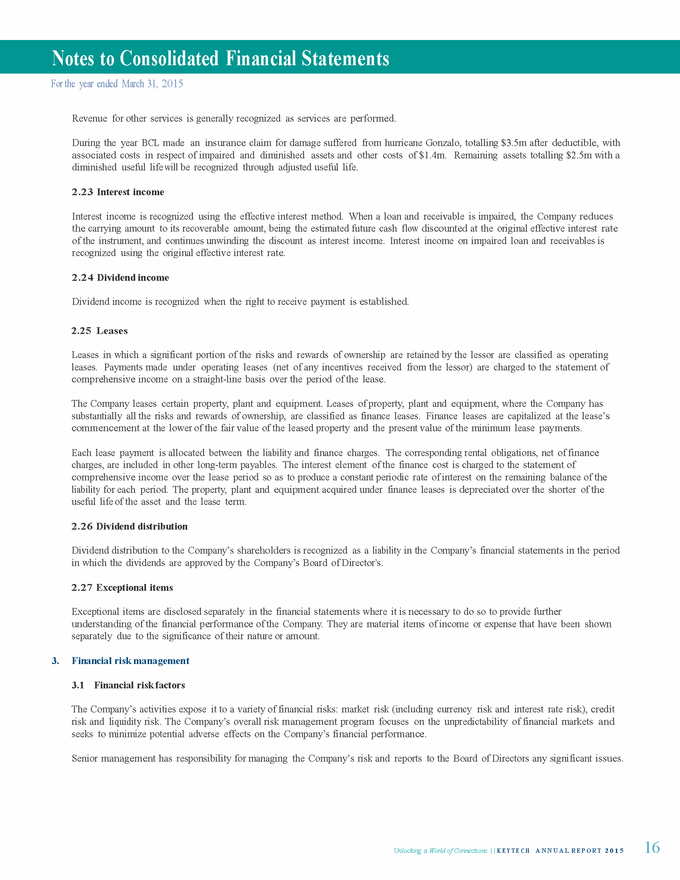
CNontessoltiodaCtoednsSotliadtaetmedenFt inofanCcaiashl SFtlaotwems ents For the year ended March 31, 2015 (a) Market risk Market risk is the risk that changes in market prices, such as foreign exchange rates and interest rates will affect the Company’s income or the value of its holdings of financial instruments. The objective of market risk management is to manage and control market risk exposures within acceptable parameters, while optimizing the return on assets. (i) Foreign currency risk The Company incurs foreign currency risk primarily on purchases and borrowings that are denominated in a currency other than the Bermuda and Cayman dollars. However, foreign currency risk is minimal, due to the fact that the Bermuda dollar is pegged to the US Dollar at a 1:1 rate and the Cayman dollar is pegged to the US Dollar at an exchange rate of 1 to 1.219. (ii) Price risk The Company is exposed to equity securities price risk because of investments held by the Company and classified on the consolidated balance sheet as available-for-sale. The fair value of available-for-sale investments is determined by reference to their quoted market prices. The Company intends to hold these investments for a period longer than one year. The Company has reviewed all available-for-sale investments held at March 31, 2015 for evidence of impairment and has determined that there is no impairment as at March 31, 2015 and there are no indicators of significant or prolonged decline in the value of the assets. Assessment by the Company of evidence of impairment involves the use of estimates as disclosed in note 4. If impairment is determined, the amount of such impairment is removed from accumulated other comprehensive income and recorded in net income for the reporting period. A 10% movement in fair values of the available-for-sale investments would impact other comprehensive income as follows: 2015 10% increase in fair values 10% decrease in fair values $ $ 110,955 (110,955) 10% was estimated by management as an appropriate threshold for sensitivity testing based on average price movements on the Bermuda Stock Exchange over a 12 month period. (iii) Cash flow and fair value interest rate risk The Company’s interest rate risk arises from long-term borrowings. Borrowings issued at variable rates expose the Company to cash flow interest rate risk which is partially offset by cash held at variable rates. During 2015, the Company’s borrowings at variable rate were denominated in USD. On April 25, 2013 the Company entered into a lending agreement with its Lender to finance the amalgamation of North Rock. The Company was required to develop an interest rate hedging strategy as part of the lending agreement. The Company hedged 30% of its total loan amount, $8,250,000, through a floating-to-fixed interest rate swap (“Swap”). The Swap was purchased on April 30, 2014 and will expire on April 30, 2018 from the Lender. No premium or fee was charged to enter the Swap. Settlement of the Swap is linked to the interest charging period on the underlying debt, three months. The Libor rate was fixed at 1.966% at the beginning of the charging period and for settlement, at the end of the period. If the Libor rate for that period is higher than the fixed rate of interest under the swap, then the Lender pays the net difference. Equally, if the Libor rate is lower than the agreed fixed rate of interest under the swap, then the Company will compensate the lender for the difference. As at the end of the current year there was no unrealized gain or loss recorded. The swap is valued using level 2 inputs. 17 Unlocking a World of Connections | | K E Y T E C H ANNUA L R E P O R T 2 0 1 5
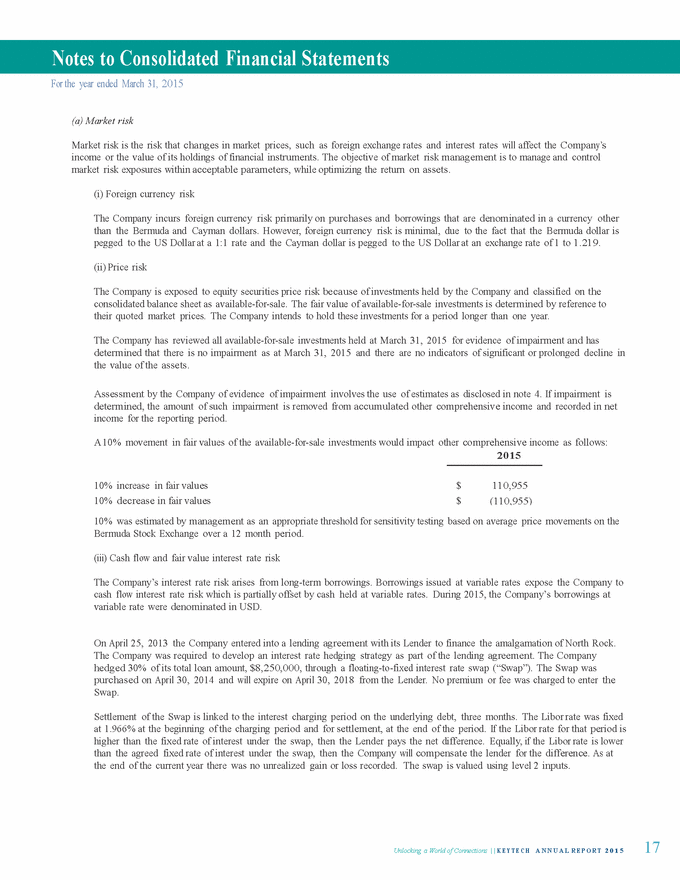
CNontessoltiodaCtoednsSotliadtaetmedenFt inofanCcaiashl SFtlaotwems ents For the year ended March 31, 2015 (b) Credit risk Credit risk is managed on group basis, except for credit risk relating to accounts receivable balances. Each local entity is responsible for managing and analyzing the credit risk for each of their new and existing clients before standard payment and delivery terms and conditions are offered. Credit risk arises from cash and cash equivalents, deposits with banks and financial institutions, credit exposures to wholesale and retail customers, including outstanding receivables and committed transactions, as well as loans receivable from associates. Management deems the credit risk associated with the loan to be minimal. For banks and financial institutions, counterparties who have minimal risk of credit default and are rated by Standard & Poor’s with credit ratings of between A-and A are used. If wholesale customers are independently rated, these ratings are used. If there is no independent rating, senior management assesses the credit quality of the customer, taking into account its financial position, past experience and other factors. Individual risk limits are set based on internal or external ratings in accordance with limits set by the Board of Directors. The utilization of credit limits is regularly monitored. Sales to retail customers are settled in cash or using major credit cards. Management does not expect any losses from non-performance by these counterparties. (c) Liquidity risk Liquidity risk, also referred to as funding risk, is the risk that the Company will encounter difficulty in raising funds to meet commitments associated with financial instruments. Liquidity risk may result from an inability to sell a financial asset quickly at or close to its fair value. Prudent liquidity risk management implies maintaining sufficient cash and marketable securities and ensuring the availability of funding through an adequate amount of committed credit facilities. The Company aims at maintaining flexibility in funding by keeping lines of funding available with relevant suppliers, bankers and related parties, sourcing appropriate currency holdings to match liabilities and pursuing prompt payment policies. As at March 31, 2015 the carrying amount of the bank overdraft facility, accounts payable, accrued liabilities, foreign tax liabilities and amounts due to related companies are equal to the contractual cash flows of the same. All are short-term in nature and due within a period of 12 months. The table below analyzes the Company’s financial liabilities into relevant maturity groupings based on the remaining period at the balance sheet date to the contractual maturity date. The amounts disclosed in the table are the contractual undiscounted cash flows. Less than 2015 Less than 3 months Between 3 months and 1 year Between 1 and 2 years Between 2 and 5 years Over 5 years Borrowings $ - $6,428,571 $6,428,571 $19,285,713 $34,342,857 Accounts payable and other liabilities 11,943,444 1,604,392 - - - $11,943,444 $8,032,963 $6,428,571 $19,285,713 $34,342,857 3.2 Capital management: The Company’s objectives when managing capital are to safeguard the Company’s ability to continue as a going concern in order to provide returns for shareholders and benefits for other stakeholders and to maintain an optimal capital structure to reduce the cost of capital. In order to maintain or adjust the capital structure, the Company may adjust the amount of dividends paid to shareholders, return capital to shareholders, issue new shares or sell assets to reduce debt. Changes were made to the Company’s dividends strategy during the year ending March 31, 2015, refer to note 21. Shares were issued as part of the acquisition of BOTCAT, refer to notes 23 and 26. 18 Unlocking a World of Connections | | K E Y T E C H ANNUA L R E P O R T 2 0 1 5
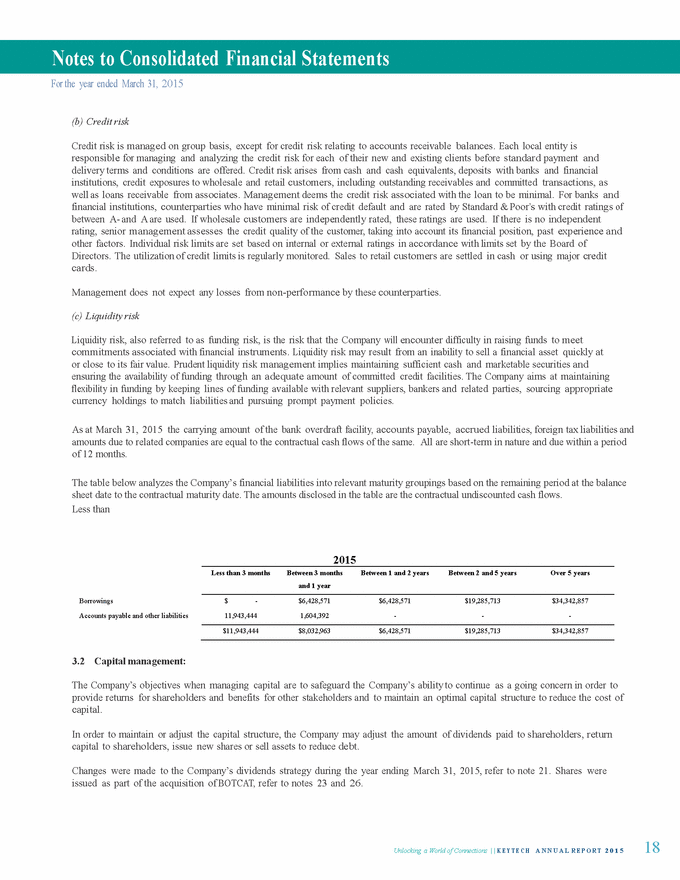
CNontessoltiodaCtoednsSotliadtaetmedenFt inofanCcaiashl SFtlaotwems ents For the year ended March 31, 2015 3.3 Fair value estimation: The table below analyzes financial instruments carried at fair value, by valuation method. The different levels have been identified as follows: • • Quoted prices (unadjusted) in active markets for identical assets or liabilities (Level 1). Inputs other than quoted prices included within level 1 that are observable for the asset or liability, either directly (that is, as prices) or indirectly (that is, derived from prices) (Level 2). Inputs for the asset or liability that are not based on observable market data (that is, unobservable inputs) (Level 3). • Level 1 Level 2 Level 3 Total Available-for-sale financial assets $ 1,097,905 $ 11,641 $ - $ 1,109,546 There was $11,641 transferred between levels 1 and 2 during the year because these investments are not actively traded. The carrying value of the Company’s other financial assets and liabilities, including loans receivable, accounts receivable, prepaid expenses, investments in associates, accounts payable, unearned income and loans payable, are considered to approximate their fair value. The majority of the Company’s loans receivable and payable, and its subordinated debt, arose in September 2014. (a) Financial instruments in level 1 The fair value of financial instruments traded in active markets is based on quoted market prices at the balance sheet date. A market is regarded as active if quoted prices are readily and regularly available from an exchange, dealer, broker, industry group, pricing service, or regulatory agency, and those prices represent actual and regularly occurring market transactions on an arm’s length basis. The quoted market price used for financial assets held by the Company is the current bid price. These instruments are included in Level 1. Instruments included in Level 1 comprise primarily BSX equity investments classified as trading securities or available-for-sale. (b) Financial instruments in level 2 The fair value of financial instruments that are not traded in an active market is determined by using valuation techniques. These valuation techniques maximize the use of observable market data where it is available and rely as little as possible on entity specific estimates. If all significant inputs required to fair value an instrument are observable, the instrument is included in level 2. If one or more of the significant inputs is not based on observable market data, the instrument is included in Level 3. Specific valuation techniques used to value financial instruments include: • • Quoted market prices or dealer quotes for similar instruments; The fair value of interest rate swaps is calculated as the present value of the estimated future cash flows based on observable yield curves; The fair value of forward foreign exchange contracts is determined using forward exchange rates at the balance sheet date, with the resulting value discounted back to present value; Other techniques, such as discounted cash flow analysis, are used to determine fair value for the remaining financial instruments. • • (c) Financial instruments in level 3 During the year ended March 31, 2013 the Company purchased 27,000 shares in Bermuda Cablevision Ltd. for $342,056. These have been removed from level 3 financial instruments during the fiscal year ended March 31, 2015 as Bermuda Cablevision is fully consolidated in the financial statements. 4.Critical accounting estimates and judgments Estimates and judgments are continually evaluated and are based on historical experience and other factors, including expectations of future events that are believed to be reasonable under the circumstances. 19 Unlocking a World of Connections | | K E Y T E C H ANNUA L R E P O R T 2 0 1 5
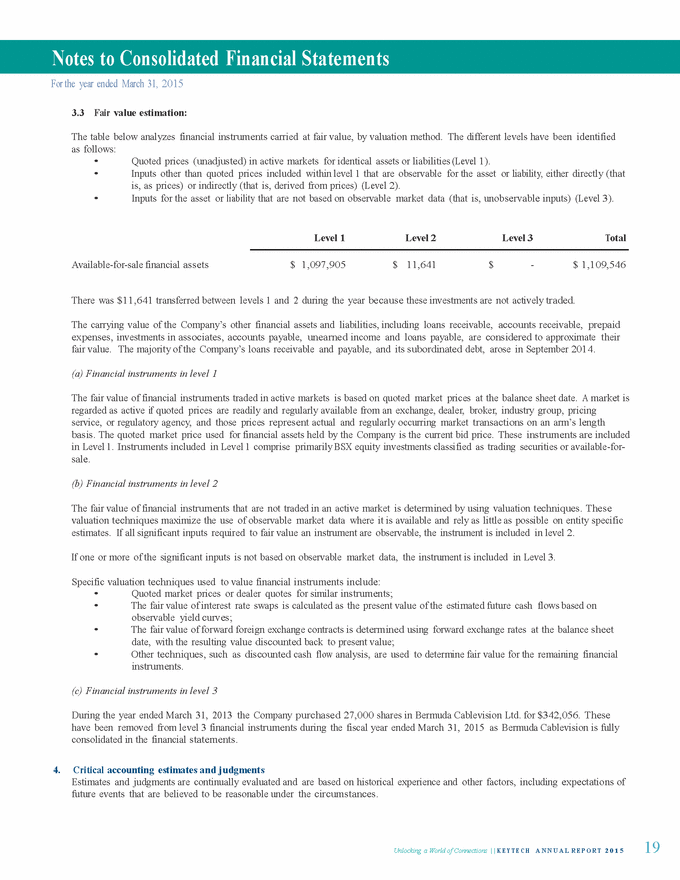
CNontessoltiodaCtoednsSotliadtaetmedenFt inofanCcaiashl SFtlaotwems ents For the year ended March 31, 2015 4.1 Critical accounting estimates and judgements The Company makes estimates and assumptions concerning the future. The resulting accounting estimates will, by definition, seldom equal the related actual results. The estimates and assumptions that have a significant risk of causing a material adjustment to the carrying amounts of assets and liabilities within the next financial year are addressed below. (a) Allowance for impairment losses on receivables In determining amounts recorded for impairment losses in the financial statements, management makes judgments regarding indicators of impairment, that is, whether there are indicators that suggest there may be a decrease in the estimated future cash flows from receivables, for example, default and adverse economic conditions. Management also makes estimates of the likely estimated future cash flows from impaired receivables as well as the timing of such cash flows. Historical loss experience is applied where indicators of impairment are not observable on individually significant receivables with similar characteristics, such as credit risks. (b) Net realizable value of materials Estimates of net realizable value are based on the most reliable evidence available at the time the estimates are made, of the amount the materials are expected to realize. These estimates take into consideration fluctuations of price or cost directly relating to events occurring after the end of the period, to the extent that such events confirm conditions existing at the end of the period. Estimates of net realizable value also take into consideration the purpose for which the materials are held. (c) Residual value and expected useful life of property, plant and equipment The residual value and the expected useful life of an asset are reviewed at each financial year-end, and, if expectations differ from previous estimates, the change is accounted for. The useful life of an asset is defined in terms of the asset’s expected utility to the Company and its subsidiaries. The recoverable amount of property, plant and equipment is dependent upon management’s internal assessment of future cash flows from the individual asset or from the cash generating units to which the asset belongs. In addition, the estimate of the amount recoverable from future use of those units is sensitive to the discount rate used. (d) Impairment of investments in associates The carrying value of investments in associates is assessed for impairment using benchmark multiples of earnings before interest, depreciation and amortization (“EBIDA”) and discounted cash flows of the Company, based on actual and forecasted results over a period of up to five years. The discount rate and benchmark multiples are assessed individually for each investment depending on the nature of its business, maturity of the business and expected future revenue growth rates. If the recoverable value is less than the carrying value of the investment in associate, an impairment expense is recognized in the period to reduce carrying value to its recoverable value. The following are key assumptions used in the impairment assessment calculations: Benchmark multiples of EBIDA Discount rate applied in cash flow projections 5¾ - 12 8% (e) Impairment of goodwill and intangible assets Determining whether goodwill and intangible assets are impaired requires an estimation of the recoverable value using value in use, of the cash-generating units to which the goodwill and intangible assets have been allocated. The cash generating unit fair value is assessed using the discounted cash flows of the cash generating unit, based on financial budgets approved by management over a period of up to five years with a terminal value at the end of the five year period. Tangible assets are deducted from the estimated enterprise value and the residual value is compared to the carrying value of goodwill and intangible assets. If the residual value is less than the book carrying value of goodwill and intangible assets, an impairment expense is recognized in the period to reduce the carrying value to its recoverable amount. The following are key assumptions used in the impairment assessment calculations: Benchmark multiples of EBIDA Discount rate applied in cash flow projections 5.0 - 6.5 9.5% 20 Unlocking a World of Connections | | K E Y T E C H ANNUA L R E P O R T 2 0 1 5
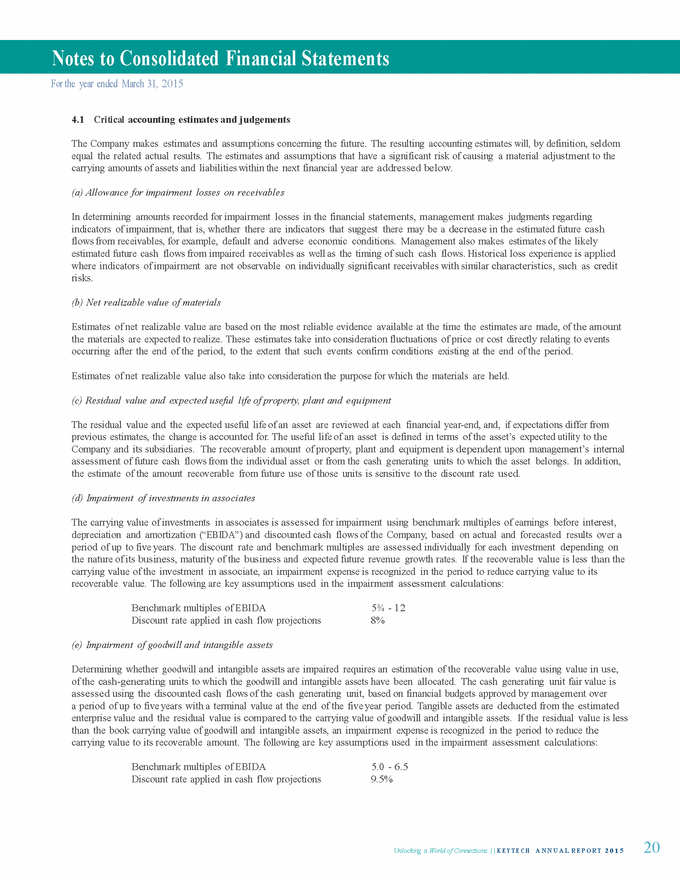
CNontessoltiodaCtoednsSotliadtaetmedenFt inofanCcaiashl SFtlaotwems ents For the year ended March 31, 2015 5. Segment information Reportable segments correspond to the Company’s internal organizational structure. The Company operates the following reportable segments, which are managed as separate business units, as they operate in different industries and require different market strategies and technologies. The Company evaluates each segment’s performance based on its contribution to consolidated net income. The accounting policies of the reportable segments are the same as those described in note 2. Cablevision Holdings Ltd. (“Cablevision”) – provides internet access and data internet products as well as subscription television services in Bermuda through its coaxial and fiber network. Segment information is presented for 7 months since acquisition. Logic Communications Ltd. (“Logic”) – provides a wide range of data internet products and services and long distance and local voice services. WestTel Limited (trading as Logic) (“Logic Cayman”) – provides fixed wireless and wireline voice and data services and subscription television services in the Cayman Islands. Bermuda Yellow Pages Limited (“BYP”) – provides print, on-line directory and digital marketing services. Cable Co. Ltd. (“Cable Co”) – provides international data services on its submarine cable system between Bermuda and the United States. Yabsta (BVI) Limited (“Yabsta”) – provides on-line search capabilities, specializing in digital advertising. The investments in associates have been aggregated under a single segment called ‘Investments in associates’ and its related disclosures are included in note 9 of these financial statements. Segment information Logic Cayman CONTINUING OPERATIONS Cablevision Logic BYP Cable Co. Yabsta Total Year ended March 31, 2015 Revenues from external customers Revenues from internal customers Depreciation and amortization Operating expenses Segment income (loss) Segment assets 19,390,908 20,265 3,828,677 14,570,666 1,011,830 34,989,630 21,882,826 1,424,227 3,463,676 18,710,146 1,133,231 37,213,655 20,353,383 53,520 6,093,122 21,366,948 (7,053,167) 73,008,909 4,273,794 180,319 25,372 3,055,449 1,373,292 3,942,310 354,856 1,705,093 2,091,976 2,762,577 (2,794,604) 18,142,418 51,000 57,000 251,733 230,966 (374,699) 1,006,934 66,306,767 3,440,424 15,754,556 60,696,752 (6,704,117) 168,303,856 21 Unlocking a World of Connections | | K E Y T E C H ANNUA L R E P O R T 2 0 1 5
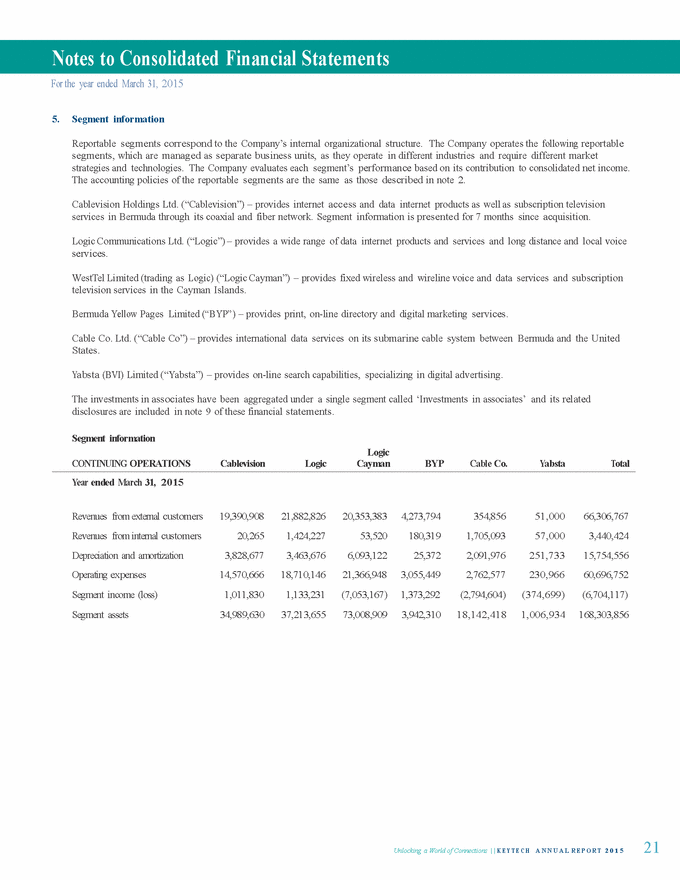
CNontessoltiodaCtoednsSotliadtaetmedenFt inofanCcaiashl SFtlaotwems ents For the year ended March 31, 2015 Reconciliations 2015 $ 66,306,767 596,736 Revenues from external customers Total segment revenues from external customers Non-segment other revenue $ 66,903,503 2015 Depreciation and amortization Total segment depreciation and amortization Non-segment depreciation and amortization Elimination of inter-company amounts $ 15,754,556 1,424,301 (1,357,995) $ 15,820,862 2015 Operating expenses Total segment operating expenses Non-segment operating expenses Elimination of inter-company amounts $ 60,696,752 6,669,617 (3,276,070) $ 64,090,299 2015 Profit for the year Total income (loss) for reportable segments Share of income of associates Finance costs Gain on investment Loss on property revaluation Non-segment other income Non-controlling interests Loss on sale of subsidiary Net proceeds on insurance claim Non-segment administrative expenses Non-segment amortization Elimination of inter-company amounts $ (6,704,117) 7,135,389 (3,216,251) 11,397,492 (1,473,245) 767,095 126,554 (18,617,231) 2,144,352 (6,669,617) (1,424,301) 668,227 $ (15,865,653) 22 Unlocking a World of Connections | | K E Y T E C H ANNUA L R E P O R T 2 0 1 5
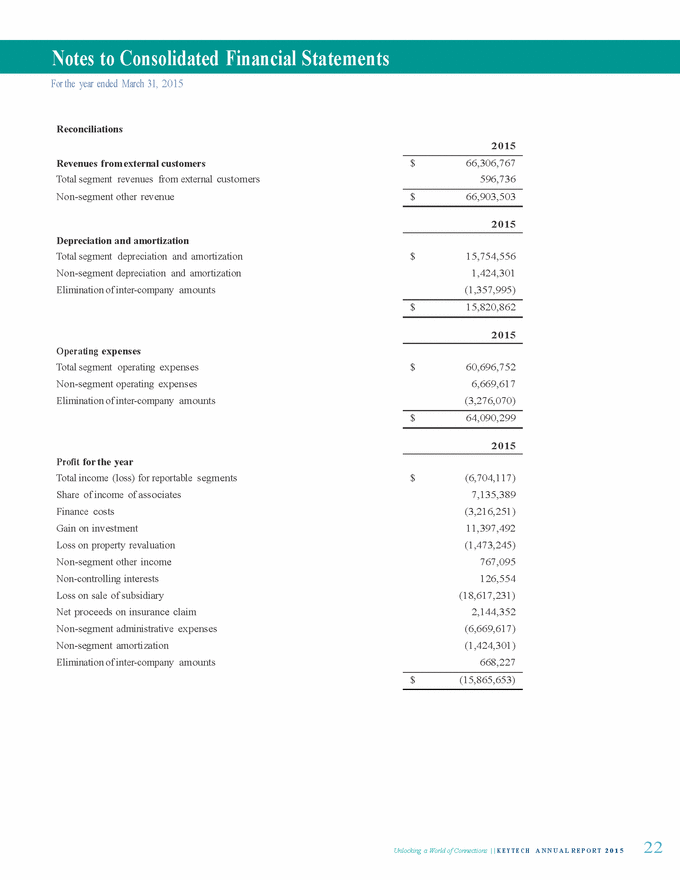
CNontessoltiodaCtoednsSotliadtaetmedenFt inofanCcaiashl SFtlaotwems ents For the year ended March 31, 2015 2015 Total assets Total assets for reportable segments Goodwill Non-segment assets $ 168,303,856 41,075,847 166,887,804 - Segment assets of disposed subsidiary Elimination of inter-company amounts (129,322,244) $ 246,945,263 Entity-wide information The breakdown of revenue from all services is disclosed on the face of the consolidated statement of comprehensive income. The Company is domiciled in Bermuda and revenue from external customers in Bermuda is $45,953,384. Total revenue from other countries is $20,353,383 which is derived from the Logic Cayman operations in the Cayman Islands. The total of non-current assets located in Bermuda is $159,452,667 and the total of such non-current assets in other countries is $69,355,674. 6. Salaries and employee benefit expenses and staff termination costs 2015 Salaries and other short-term benefits Gross staff termination costs Employer pension contributions $ 19,961,551 402,816 934,220 $ 21,298,587 Salaries and employee benefit expenses per consolidated statement of comprehensive income Staff termination costs per consolidated statement of comprehensive income $ 20,854,821 443,766 $ 21,298,587 7. General and administrative expenses 2015 Administrative Consultants and professional fees Marketing and selling Bad debt expense (note 13) Insurance $ 4,652,639 4,526,087 1,720,457 1,380,058 1,008,509 $ 13,287,750 8. Government license fee Certain subsidiaries of the Company are required to pay a license fee to the Governments of Bermuda or the Cayman Islands. The Government of Bermuda is paid a ‘Government Authorization Fee’ (GAF) of 2.05% and a ‘Regulatory Authority Fee’ (RAF) of 1.75% of total gross revenue, less certain allowable deductions specified in its license. The Government of the Cayman Islands is paid a 23 Unlocking a World of Connections | | K E Y T E C H ANNUA L R E P O R T 2 0 1 5
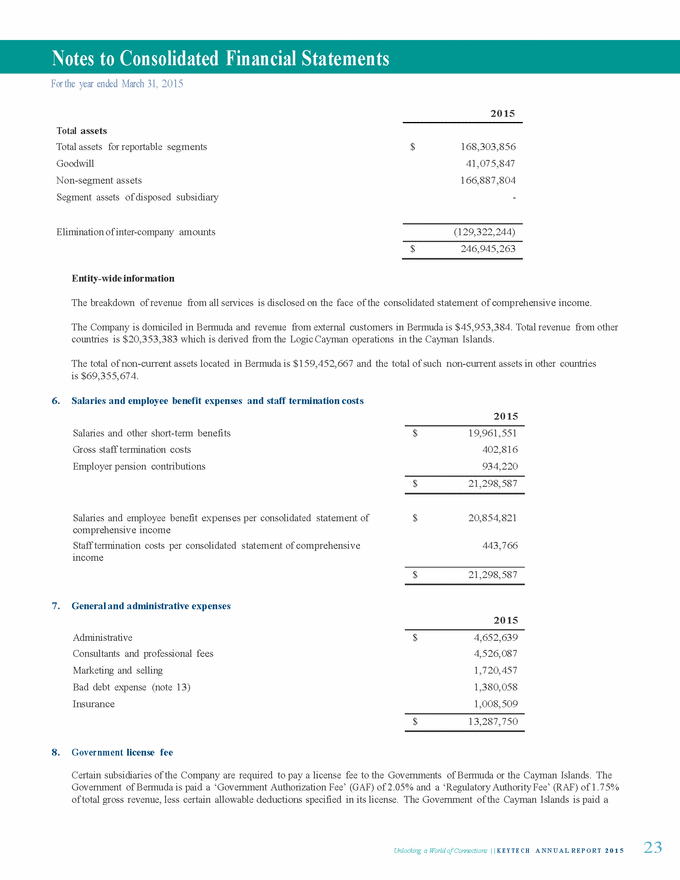
CNontessoltiodaCtoednsSotliadtaetmedenFt inofanCcaiashl SFtlaotwems ents For the year ended March 31, 2015 license fee based on 6% of revenues less certain allowable deductions specified in its license. The license fees for the year ended March 31, 2015 were approximately $2,881,423, which is included within government taxes, fees and levies in the consolidated statement of comprehensive income. Cedar is required to pay annual regulatory fees to the Federal Communications Commission (“FCC”) in the United States for the submarine cable. Fees are calculated on a calendar year. In the current year, the Company incurred $163,900 in FCC fees. 9. Investments in associates 2015 At April 1 $ 33,938,579 Share of operating profit Interest charged Amortization of intangibles 7,432,181 68,982 (365,774) Net share of income of associates Purchase of additional investments Transfer of associate to subsidiary on gaining control 7,135,389 101,660 (8,960,635) Loan repayments and interest received Dividends received (704,983) (5,749,235) At March 31 $ 25,760,775 The results of all three principal associates, and the aggregated assets (including goodwill) and liabilities are as follows: Countries of incorporation Assets Liabilities Revenues Net Profit Bermuda $ 52,310,211 $ 13,083,917 $ 61,916,295 $ 10,963,126 March 31, 2015 Set out below are the associates of the Company during the year ended March 31, 2015 which, in the opinion of the directors, are material to the Company. The associates as listed below have share capital consisting solely of ordinary shares, which are held directly by the Company; the country of incorporation or registration is also their principal place of business. CellOne The Company held approximately 42% of the common shares of the CellOne. Effective May 2, 2011 the Company accounts for its investment as an investment in associate, whereby the investment is recorded at cost, adjusted to recognize the Company’s share of earnings or losses of the amalgamated company and reduced by dividends received. Cablevision Holding Ltd. (“CHL”) For the period April 1, 2014 to September 3, 2014 the Company reported its 40% ownership in CHL as investment in associate in BCL. On September 3, 2014 the Company acquired the remaining 60% of CHL, see note 26, and effectively gained control of CHL and its underlying investment, BCL. For the remainder of the reporting period CHL has been consolidated as a subsidiary. QV Holdings Ltd. (“QuoVadis”) QuoVadis is a provider of managed security services. The Company owns an equity interest in QuoVadis of approximately 30%. The Company has also provided a subordinated loan to QuoVadis of $500,000 with an interest rate of 5% and no fixed repayment terms. Repayment of the loan balance is subordinated to convertible preference shares owned by another shareholder. The loan is secured by the assets of QuoVadis. 24 Unlocking a World of Connections | | K E Y T E C H ANNUA L R E P O R T 2 0 1 5
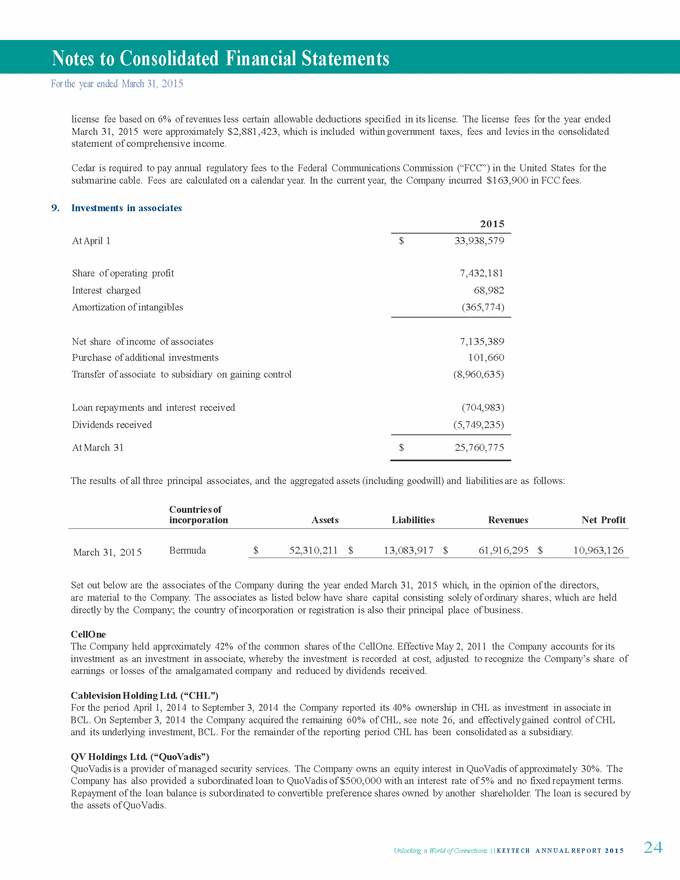
CNontessoltiodaCtoednsSotliadtaetmedenFt inofanCcaiashl SFtlaotwems ents For the year ended March 31, 2015 10. Finance income and costs 2015 Finance income: - - - - interest income on short-term bank deposits interest income on loan receivable interest income on available-for-sale financial assets dividend income on available-for-sale financial assets $ 322 114,521 22,513 55,694 193,050 Finance costs: - - - - - - interest paid - long-term loan administration expense - long term loan interest on sub-ordinated debt interest paid - overdraft facility investment fees on available-for-sale financial assets swap loss (1,310,745) (562,500) (1,142,511) (64,734) (5,025) (130,736) (3,216,251) $ (3,023,201) Net finance (costs) income 11. Earnings per share Basic earnings per share is calculated by dividing the profit attributable to equity holders of the Company by the weighted average number of ordinary shares in issue during the year excluding ordinary shares shares. purchased by the Company and held as treasury 2015 (Loss) Profit from operations attributable to owners of the parent Weighted average number of ordinary shares in issue Earnings per share $ (13,239,179) 14,949,263 $ (0.88) Diluted earnings per share is calculated by adjusting the weighted average number of ordinary shares outstanding to assume conversion of all dilutive potential ordinary shares. The company has 1,763,085 dilutive potential ordinary shares. See note 26. 2015 (Loss) Profit from operations attributable to owners of the parent $ (13,239,179) 14,949,263 1,763,085 Weighted average number of ordinary shares Adjustment for shares held for issue in issue Weighted average number of ordinary shares earnings per share for diluted 16,712,348 Diluted earnings per share from continued operations Diluted earnings per share from discontinued operations $ (0.95) 0.16 Diluted earnings per share from (loss) profit for the year $ (0.79) 25 Unlocking a World of Connections | | K E Y T E C H ANNUA L R E P O R T 2 0 1 5
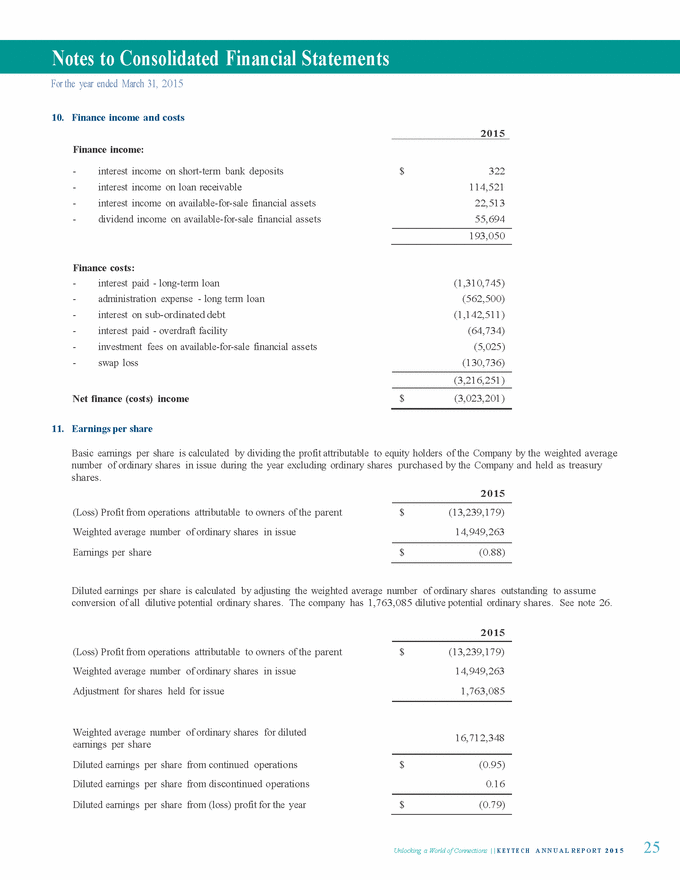
CNontessoltiodaCtoednsSotliadtaetmedenFt inofanCcaiashl SFtlaotwems ents For the year ended March 31, 2015 12. Cash and cash equivalents March 31, 2015 Cash at bank and in hand (excluding bank overdraft) Short-term deposits $ 3,647,690 69,941 $ 3,717,631 Cash and cash equivalents include the following for the purposes of the statement of cash flows: March 31, 2015 Cash and cash equivalents Bank overdraft (note 20) $ 3,717,631 (779,450) $ 2,938,181 13. Accounts receivable March 31, 2015 Trade receivables Less: provision for impairment of trade receivables Trade receivables – net Receivables from related parties Other receivables $ 7,658,905 (2,354,852) 5,304,053 264,673 2,844,813 $ 8,413,539 The aging of trade receivables at the reporting date was: March 31, 2015 Impairment Gross Not past due $ 44,940 49,338 133,668 2,126,906 $ 4,316,936 493,382 383,000 2,465,587 Past due 31 – 60 days Past due 61 – 90 days More than 90 days 7,658,905 $ 2,354,852 $ The movement in allowance for doubtful debts in respect of trade receivables during the year was as follows: March 31, 2015 Balance at beginning of year Eliminated on disposal of subsidiary Provision for receivables impairment Receivables written off during the year as uncollectible Provision for receivables impairment upon business combinations $ 2,865,082 (1,334,717) 983,621 (500,348) 341,214 Balance at end of year $ 2,354,852 26 Unlocking a World of Connections | | K E Y T E C H ANNUA L R E P O R T 2 0 1 5
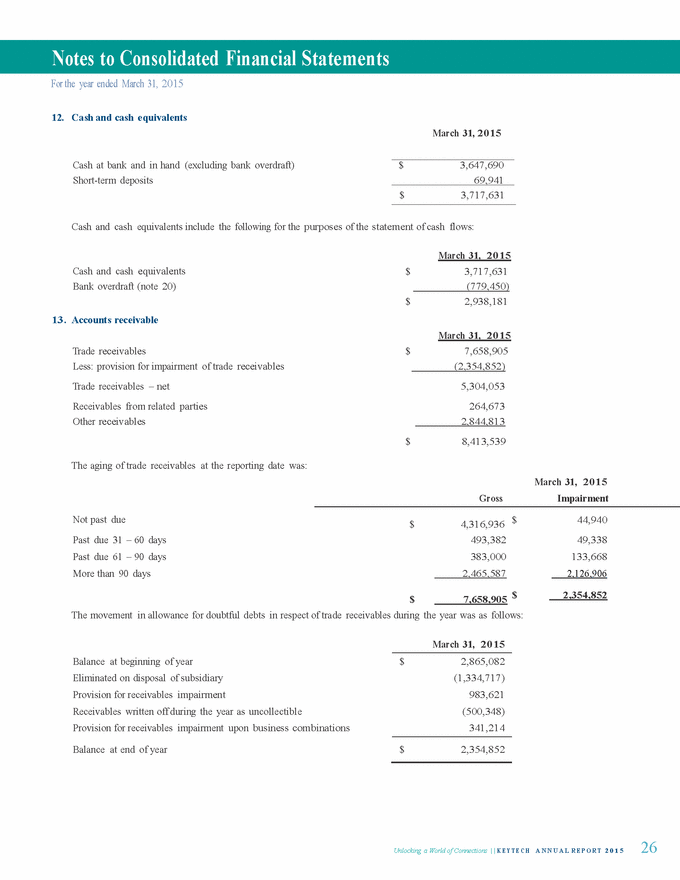
CNontessoltiodaCtoednsSotliadtaetmedenFt inofanCcaiashl SFtlaotwems ents For the year ended March 31, 2015 The creation and release of provision for impaired receivables have been included in ‘general and administrative expenses’ in the consolidated statement of comprehensive income (note 7). Amounts charged to the allowance account are generally written off, when there is no expectation of recovering additional cash. The other classes within trade and other receivables do not contain impaired assets. The maximum exposure to credit risk at the reporting date is the carrying value of each class of receivables mentioned above. The Company does not hold any collateral as security. 14. Materials March 31, 2015 Voice equipment and accessories Computer equipment $ 31,424 1,845 33,269 - Allowance $ 33,269 The cost of materials recognized as an expense and included in ‘operations and maintenance expenses’ was $270,535. . Prepaid expenses and other current assets March 31, 2015 15. Maintenance Deferred production costs (note 2.12) Deposits for capital projects* Insurance Government taxes Other prepaid expenses and current assets $ 879,938 1,918,938 - 509,673 60,109 645,603 $ 4,014,261 *In the prior year Logic Cayman placed a deposit of KYD $606,849 with a contractor for installation of fibre optic cables. The deposit was repayable in full to Logic Cayman within 30 days of the contractual minimum of $1,398,000 having been reached. Due to reduced fiber build the contract minimums were not met and an agreement was made to settle for KYD $245,000 (BDA $291,667). As a result the remaining deposit of KYD $361,849 (BDA $430,773) became part of fiber build cost and was accordingly capitalized and amortized. 16. Available-for-sale financial assets March 31, 2015 Balance at beginning of year Disposals $ 1,451,833 (342,287) $ 1,109,546 Available-for-sale financial assets include equity securities of companies banking and are denominated in Bermuda dollars. in Bermuda which are engaged in telecommunications and 27 Unlocking a World of Connections | | K E Y T E C H ANNUA L R E P O R T 2 0 1 5
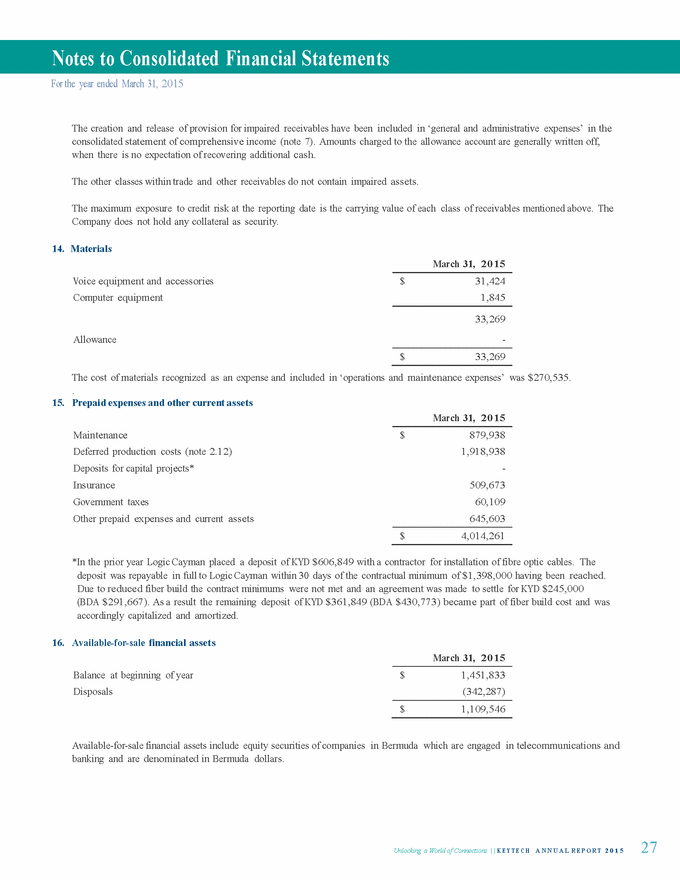
CNontessoltiodaCtoednsSotliadtaetmedenFt inofanCcaiashl SFtlaotwems ents For the year ended March 31, 2015 17. Property, plant and equipment Land Leased Under Capital Lease Buildings Leased Under Capital Lease Buildings and Fixtures Plant and Facilities Submarine Cable System Machinery and Equipment Capital work in progress Land Total Cost: March 31, 2014 $ 3,752,442 1,000,000 50,642,093 831,398 146,745,812 27,074,696 34,475,726 11,037,060 275,559,227 Additions Transfers Marrk to market Disposals / retirements Transfers on disposal of subsidiary Business combinations 620,688 - 4,435,121 (46,941,122) 17,120,199 3,349,143 - - (146,404,810) - 2,191,829 10,719,024 - (11,797,455) - 5,876,022 (10,719,024) - (3,607,046) - 12,037,682 - 5,580,970 (210,331,952) 18,030,593 - 1,145,849 (1,581,519) 910,394 - - - - - - - - - - - - 1,215,585 - 8,985,321 - 29,513,496 - 11,205,652 1,674,260 52,594,314 March 31, 2015 5,442,751 1,000,000 34,862,300 831,398 33,203,641 27,074,696 46,794,776 4,261,272 153,470,834 March 31, 2014 $ - - - - 29,089,087 1,159,114 167,705 16,628 118,903,004 3,249,319 9,604,167 1,813,966 19,369,578 5,153,091 - - 177,133,541 11,392,118 Charge for the year – continuing operations Charge for the year - discontinued operations - - 914,241 - 2,130,598 - 431,122 - 3,475,961 Marrk to market Transfers on disposal of subsidiary Eliminated on disposals / retirements - - (6,408,105) - - - - - (6,408,105) - - 8,190,853 - - - - - 8,190,853 - - (28,450,343) - (120,477,462) - (8,913,634) - (157,841,439) March 31, 2015 - - 4,494,847 184,333 3,805,459 11,418,133 16,040,157 - 35,942,929 Net book values: March 31, 2015 $ 5,442,751 $ 1,000,000 $ 30,367,453 $ 647,065 $ 29,398,183 $ 15,656,563 $ 30,754,619 $ 4,261,272 $ 117,527,905 During the year ended March 31, 2015 management has determined that no impairment charges against property, plant and equipment are required. 28 Unlocking a World of Connections | | K E Y T E C H ANNUA L R E P O R T 2 0 1 5
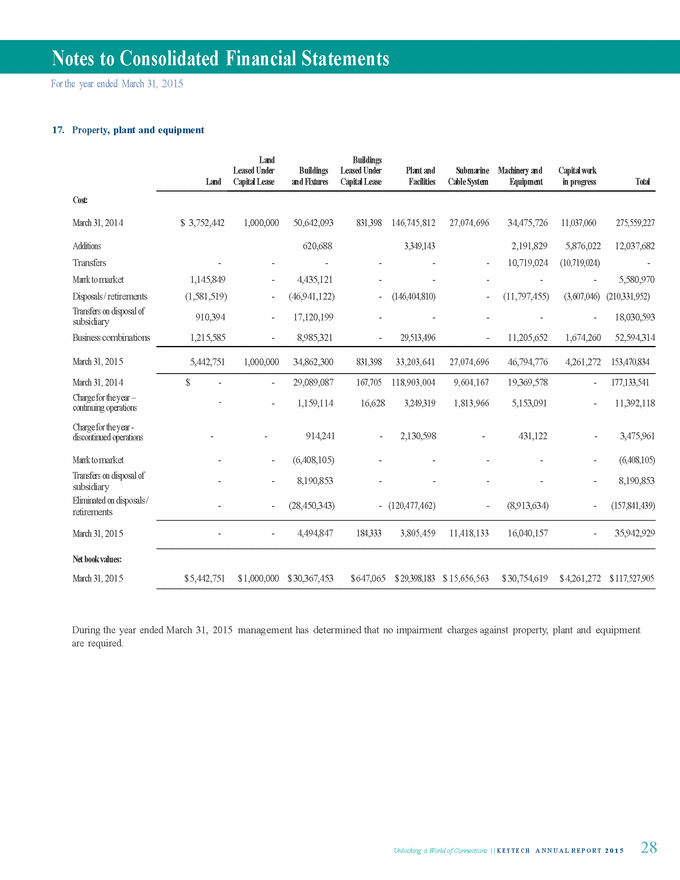
CNontessoltiodaCtoednsSotliadtaetmedenFt inofanCcaiashl SFtlaotwems ents For the year ended March 31, 2015 18. Intangible assets Computer software and other intangible assets Indefeasible right of use (IRUs) Goodwill Total Cost: March 31, 2014 Additions Eliminated on disposal Business combinations $13,362,617 - - 1,029,817 28,645,455 2,971,386 (8,360,556) 20,662,103 11,047,267 - - 30,028,581 53,055,339 2,971,386 (8,360,556) 51,720,501 March 31, 2015 Amortization: 14,392,434 43,918,388 41,075,848 99,386,670 March 31, 2014 $10,748,857 7,217,379 - 17,966,236 Charge for the year continuing operations Charge for the year discontinued operations Eliminated on disposals 983,333 - - 3,445,411 238,382 (3,666,558) - - - 4,428,744 238,382 (3,666,558) March 31, 2015 11,732,190 7,234,614 - 18,966,804 Net book values: March 31, 2015 $ 2,660,244 $ 36,683,774 $ 41,075,848 $ 80,419,866 19. Accounts payable and accrued liabilities March 31, 2015 Trade payables Amounts due to related parties Accrued liabilities Accrued payroll liabilities $ 2,988,868 11,169 7,349,706 3,198,093 $ 13,547,836 29 Unlocking a World of Connections | | K E Y T E C H ANNUA L R E P O R T 2 0 1 5
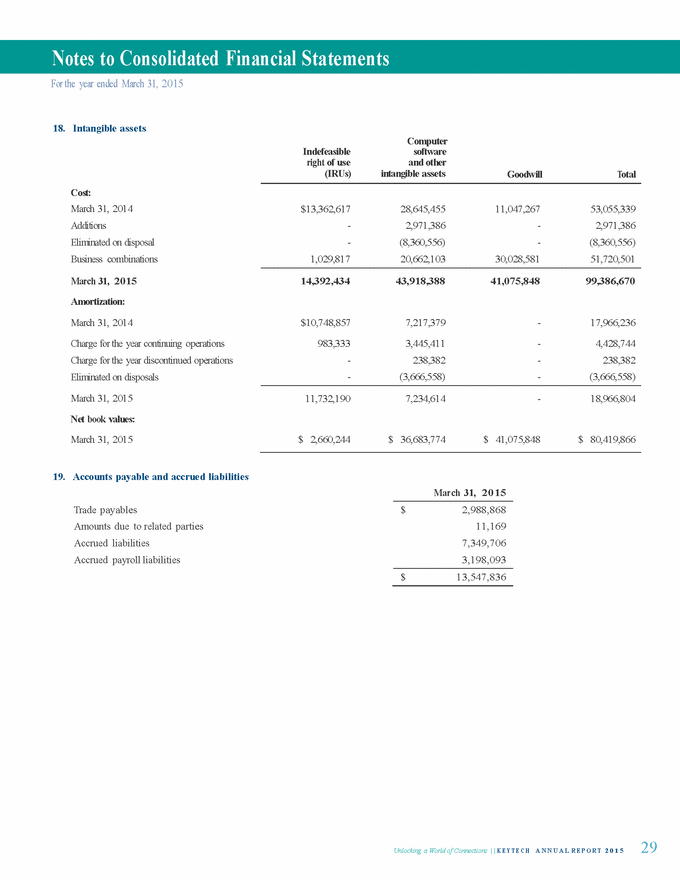
CNontessoltiodaCtoednsSotliadtaetmedenFt inofanCcaiashl SFtlaotwems ents For the year ended March 31, 2015 20. Borrowings Current March 31, 2015 Bank overdraft Bank borrowings Preferred share redemption amounts unclaimed $ 779,450 6,428,571 687,116 7,895,137 Non-current Bank borrowings 35,357,143 Sub-ordinated debt 24,700,000 Total borrowings $ 67,952,280 (a) Bank borrowings The bank overdraft is subject to a $5,000,000 limit, incurs interest expense at a rate equal to three month Libor plus 3% on amounts drawn and is secured by the Fixed and Floating Charge, as well as the Joint & Several Guarantee from BCL, Logic, Cable and Cedar. Total interest expense in relation to the overdraft facilities was $64,734 for the year ended March 31, 2015 and is included in finance costs in the consolidated statement of comprehensive income. The bank overdraft facility expired on April 25, 2015 and was renewed until October 31, 2015. Bank borrowings mature in September 2021, have set terms of repayment and bear interest at the Libor rate plus 3.25% per annum. Total interest expense in relation to bank borrowings was $1,310,745 for the year ended March 31, 2015 an d is included in finance costs in the consolidated statement of comprehensive income. See note 26 for further loan details. Total bank borrowings include secured liabilities of USD $41,785,714. Bank borrowings are secured by the property and assets of the following subsidiary companies: Logic, Cable, Cedar, Chancery Holdings Limited, KeyTech Holdings Limited (“KHL”), Wansunt Company Limited, WestStar and Logic Cayman. See note 26. (b) Preferred share redemption amounts unclaimed The Company exercised its right to redeem the preferred shares effective November 15, 2003. Total number of preferred shares was 2,613,445. As a result no preferred shares are now in issue. As at March 31, 2015, not all preferred shares had been presented to the Company in exchange for cash. The preferred shares do not accrue dividends beyond the redemption date. (c) Subordinated debt The Company issued subordinate debt to finance the BOTCAT transaction on September 3, 2015, see note 26. The notes have a term of 6 years and may be repaid in part or in full at any time within the term without penalty or the prior approval. The note bears interest at a rate of 8% per annum for year 1, 9% per annum for year 2 and 10% per annum thereafter. Interest is payable on June 30th and December 31st each year. 21. Dividends per share The dividends paid for the first quarter of 2015 was $1,310,727 ($0.09 per share). At the Board meeting held in September 2014, it was resolved that dividends would be temporarily suspended for the quarters ended September 2014, December 2014 and March 2015. 30 Unlocking a World of Connections | | K E Y T E C H ANNUA L R E P O R T 2 0 1 5
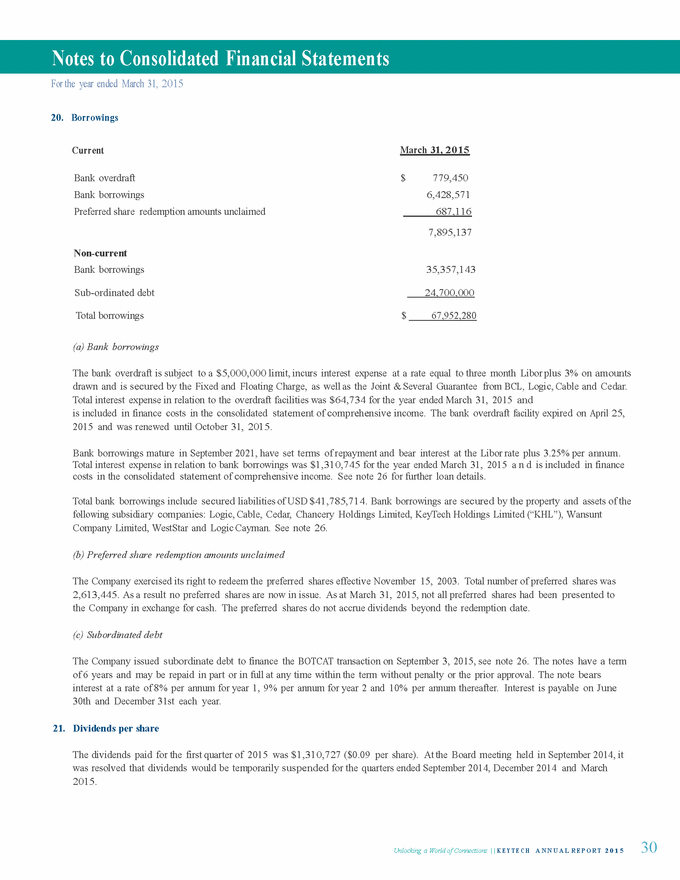
CNontessoltiodaCtoednsSotliadtaetmedenFt inofanCcaiashl SFtlaotwems ents For the year ended March 31, 2015 22. Pension and retirement augmentation plan The pension and retirement augmentation plan was disposed of during the year ended March 31, 2015 as part of the sale of BTC. 23. Share capital March 31, 2015 Authorized – 21,546,220 common shares of par value $0.25 each Authorized – 2,615,445 preferred shares of par value $1 each Issued and outstanding 15,224,745 $ 3,806,197 Common shares All shares issued by the Company were fully paid. As part of the BOTCAT transaction, see note 26, the Company holds 1,763,085 shares for issue. These shares will be issued on March 3, 2016 at the prevailing market rate, provided there are no claims made against the transaction indemnifications. These shares have been recorded as held for issue in equity at market rate on BOTCAT transaction date. 24. Non-controlling interests On February 21, 2007 Yabsta was incorporated, which is an on-line search platform, specializing in digital advertising. Yabsta was incorporated with the Company owning a 51% controlling interest. As a result of the BOTCAT transaction, see note 26, the Company acquired a further 60% of CHL and effectively gained control of CHL and BCL. CHL has been consolidated as a subsidiary since acquisition. Non-controlling interests of $6,914,207 at March 31, 2015 in the consolidated balance sheet are classified as equity but are presented separately from the parent shareholder’s equity. 2015 At April 1 Net (loss) income attributable to minority shareholder Non-controlling interest on customer base intangible Non-controlling interest arising on business combination At March 31 $ 534,866 (126,554) 1,958,222 4,547,673 $ 6,914,207 25. Commitments and contingencies a) Capital commitments: There are no commitments for capital expenditure, for which no provision has been made in these financial statements, for the fiscal years ended March 31, 2015. 31 Unlocking a World of Connections | | K E Y T E C H ANNUA L R E P O R T 2 0 1 5
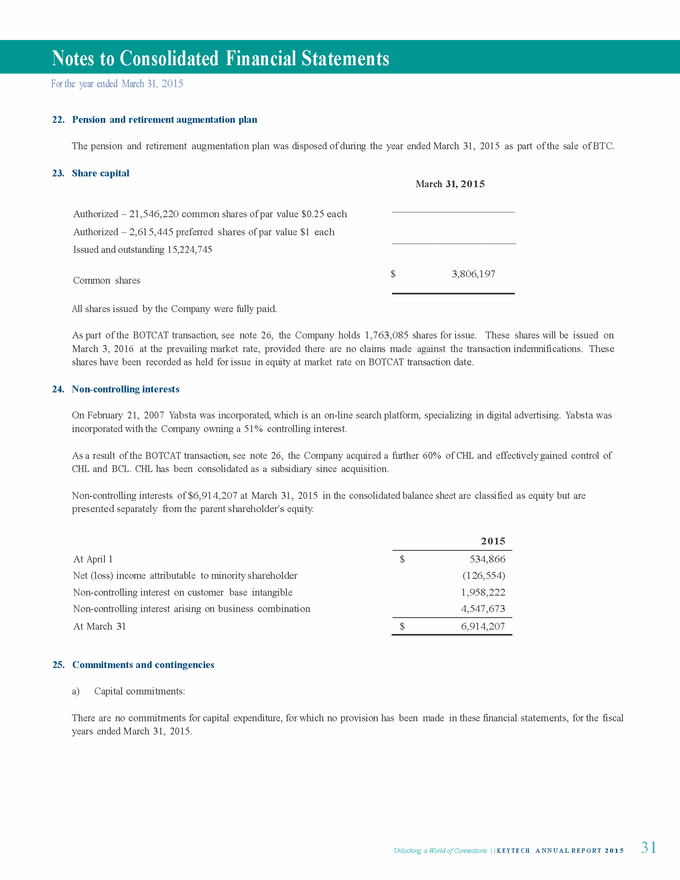
CNontessoltiodaCtoednsSotliadtaetmedenFt inofanCcaiashl SFtlaotwems ents For the year ended March 31, 2015 b) Lease commitments: Unexpired commitments under operating lease agreements for the Company’s premises, telecommunications capacity and equipment are payable as follows: 2015 Within 1 year From 1 – 2 years From 2 – 3 years From 3 – 4 years From 4 – 5 years Over 5 years $ 7,937,861 5,694,570 4,441,139 3,504,298 2,238,995 8,372,172 $ 32,189,035 Lease payments under these operating leases recognized within operations and maintenance expenses in the consolidated statement of comprehensive income for the year aggregated approximately $2,028,071. c) Contingent liabilities: There are no contingent liabilities to disclose relating to the fiscal years ended March 31, 2015. 26. Business combinations During the year ended March 31, 2015: On September 3, 2014 Logic Cayman, doing business in Cayman, acquired BOTCAT Holdings Ltd. (“BOTCAT”), a company incorporated in Cayman, for a total purchase price of $66,294,750, plus 2,424,242 common shares of the Company issued out of the authorized share capital. Of these shares, 661,157 were issued September 3, 2014 and recorded at fair value at that date. The remaining shares will be issued 18 months from closing at the prevailing market rate, provided there are no claims made against the transaction indemnifications. The remaining shares have been recorded as contingent shares in equity at market rate on acquisition. BOTCAT owned WestStar T.V. Limited (“WestStar”) in Cayman, which in turn owned an interest in Cablevision Holdings Limited in Bermuda. Following completion of the acquisition, the Company has a controlling interest of 84.6% in BCL and a 100% interest in WestStar. The acquisition of BOTCAT was financed through debt and equity. The Company entered into a term loan facility agreement with a local bank for a total of $45,000,000 (Tranche A and Tranche B). The term loan facility agreement is secured by the assets of Logic, Cable, Cedar, Chancery Holdings Limited, KeyTech Holdings Limited (“KHL”), Wansunt Company Limited, WestStar and Logic Cayman. The term loan facility has set terms of repayment and bears interest at the Libor rate plus 3.25% per annum. In the case of the Tranche A loan, annual principal repayments of $4,375,725 are payable quarterly on each quarter end in equal amounts of $1,093,931 commencing December 31, 2014. In the case of the Tranche B loan, annual principal repayments of $2,052,846 are payable quarterly on each quarter end in equal amounts of $513,212 per quarter commencing December 31, 2014. The maturity date of the loan is September 2021. The remaining $24,700,000 in debt financing was in the form of subordinated debt. The notes have a term of 6 years and may be repaid in part or in full at any time within the term without penalty or the prior approval. The note bears interest at a rate of 8% per annum for year 1, 9% per annum for year 2 and 10% per annum thereafter. Interest is payable on June 30th and December 31st each year. 32 Unlocking a World of Connections | | K E Y T E C H ANNUA L R E P O R T 2 0 1 5
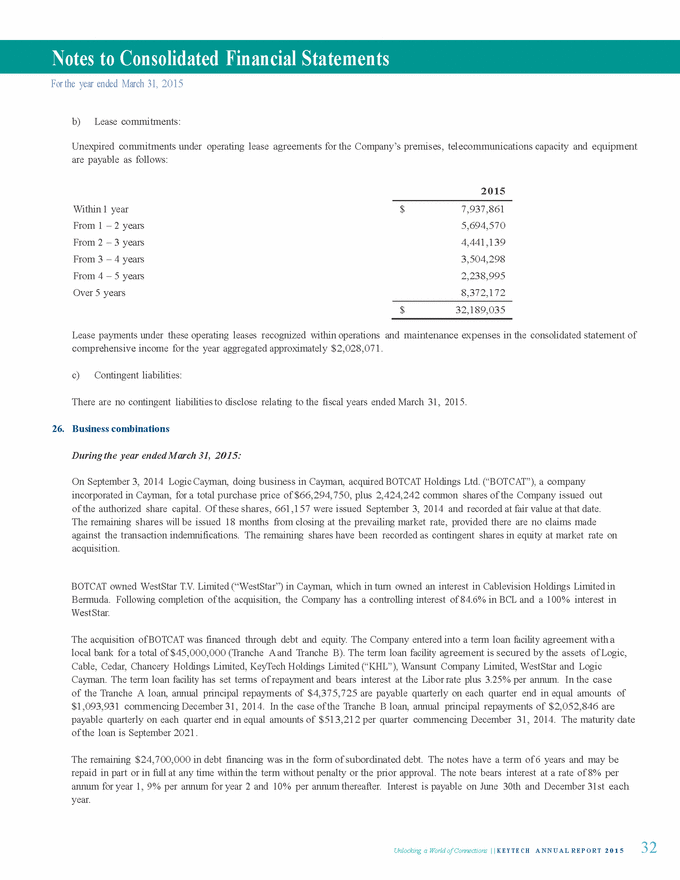
CNontessoltiodaCtoednsSotliadtaetmedenFt inofanCcaiashl SFtlaotwems ents For the year ended March 31, 2015 The following table summarizes the consideration paid for BOTCAT, the fair value of assets acquired and liabilities assumed. Total cash consideration Share consideration Total subordinated debt $ 41,594,750 10,303,028 24,700,000 Total consideration $ 76,597,778 Recognized amounts of identifiable assets acquired and liabilities assumed Cash and cash equivalents Property, plant and equipment Intangible assets Assets held for sale (CITN) Trade and other receivables Prepaid expenses Trade and other payables $ 1,181,777 38,657,607 1,029,817 1,074,827 953,839 1,227,082 (4,862,141) Total identifiable net assets $ 39,262,808 Customer base - CableVision Customer base - WestStar Goodwill – CableVision Goodwill - WestStar 6,336,246 7,514,023 9,222,349 14,262,352 Total $ 76,597,778 Acquisition-related costs of $2,190,461 have been charged to other operating expenses in the consolidated statement of comprehensive income for year ended March 31, 2015. The original holding in CHL has been revalued and as a result goodwill of $6,543,880 and other intangibles of $4,853,612 were recorded in the books. 27. Related parties The following transactions were carried out with related parties: 2015 (a) Year-end balances arising from sales / purchases of goods / services $ 264,673 Receivables from related parties: - Associates Payables to related parties: - Associates Sales to related parties: - Associates Purchases from related parties: - Associates $ 11,167 $ 401,060 $ 74,523 33 Unlocking a World of Connections | | K E Y T E C H ANNUA L R E P O R T 2 0 1 5
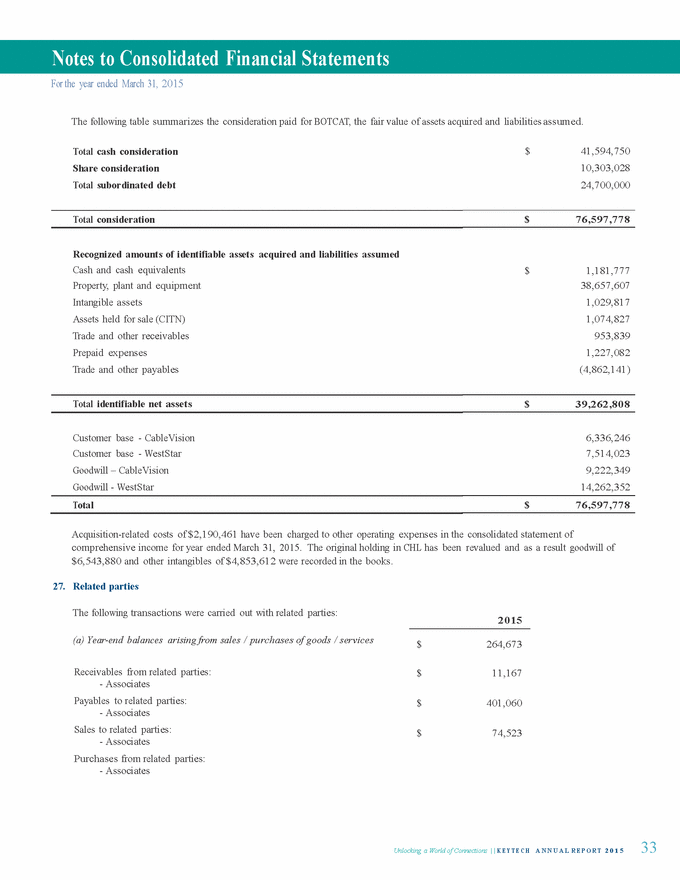
CNontessoltiodaCtoednsSotliadtaetmedenFt inofanCcaiashl SFtlaotwems ents For the year ended March 31, 2015 The receivables from related parties arise mainly from sale transactions and are due one month after the date of sale. The receivables are unsecured in nature and bear no interest. No provisions are held against receivables from related parties. Goods are sold based on the price lists in force and terms that would be available to third parties. (b) Key management compensation Key management includes Directors (executive and non-executive) and members of Senior Management. The compensation paid or payable to key management for employee services is shown below: 2015 Salaries and other short-term employee benefits $ 4,682,019 (c) Loans to related parties 2015 Loans to associates: At April 1 Loan repayments received Interest charged $ 1,401,685 (704,983) 18,982 At March 31 $ 715,684 $715,684 were considered capital contributions to the associates and are included as ‘investments in associates’ on the face of the balance sheet. The promissory note to CHL was repaid in full during the year ended March 31, 2015. Advances under the loan facility to QuoVadis bear interest at 5% and are secured on the fixed and floating assets of QuoVadis. Interest relating to all associates loans is included as a component of equity earnings in associates in the consolidated statement of comprehensive income. No provision was required in 2015 for the loans made to associates. 28. Discontinued Operations On September 3, 2014 BTC was sold to Barrie OpCo Limited for cash consideration of $25,000,000 and a promissory note with face value of $5,000,000. The promissory note was fully paid in June 2015. BTC results are presented in these financial statements as a discontinued operation. The cash proceeds of this transaction were used to retire the Company’s existing debt relating to the North Rock transaction. The net accounting loss on sale was $18,397,232 plus $220,000 in foreign exchange fees, and was recognized in the consolidated statement of comprehensive income during the year ended March 31, 2015. Cash received Loan receivable Net assets of BTC on disposal Loss on disposal $ 25,000,000 5,000,000 (48,397,231) $ (18,397,231) 34 Unlocking a World of Connections | | K E Y T E C H ANNUA L R E P O R T 2 0 1 5
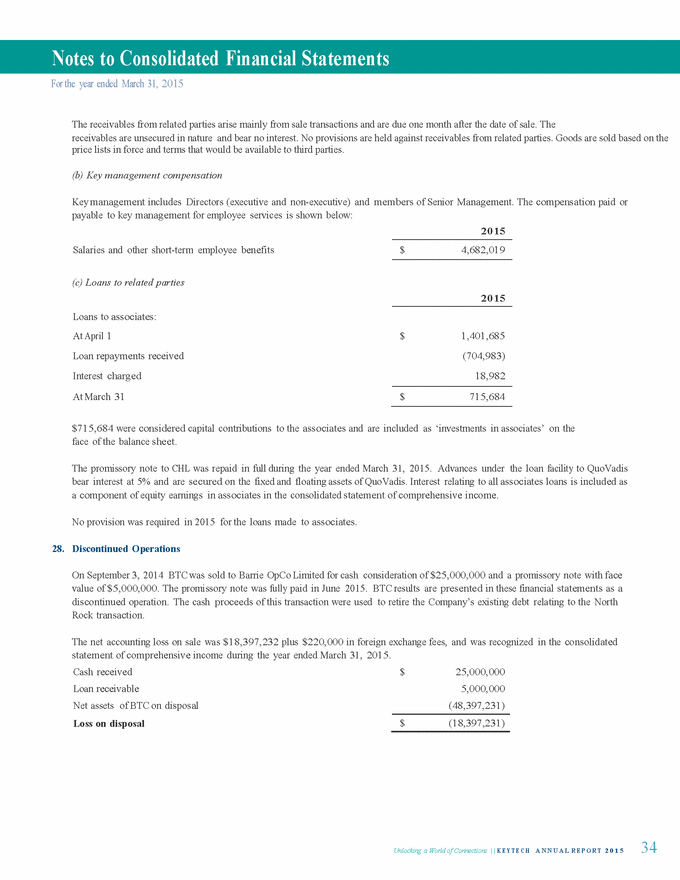
CNontessoltiodaCtoednsSotliadtaetmedenFt inofanCcaiashl SFtlaotwems ents For the year ended March 31, 2015 The profit attributable to discontinued operations that is presented in the statement of operations at March 31, 2015 is made up as follows: 2015 Operating revenue Operating expenses Interest Loss on disposal $ 16,968,261 (14,221,820) (119,967) $ 2,626,474 29. Held for Sale Operations Presented separately on the balance sheet are assets and liabilities held for sale that relate to the Cayman business unit CITN. An agreement has been reached subsequent to March 31, 2015 to sell CITN assets and therefore the assets and liabilities are disclosed separately in the current year. See note 30. 30. Events after the reporting period On July 15, 2015 the Company completed a transaction through one of its subsidiaries which resulted in the Company now owning 100% of BCV creating a liability of $3.4m to acquire the minority interest. These payments are due as certificates are presented by previous minority shareholders. On July 28, 2015 the Company sold all of its assets related to the television production business in Cayman, which was acquired as part of the BOTCAT transaction and expect to receive net proceeds of approximately $700,000 after associated costs. 35 Unlocking a World of Connections | | K E Y T E C H ANNUA L R E P O R T 2 0 1 5
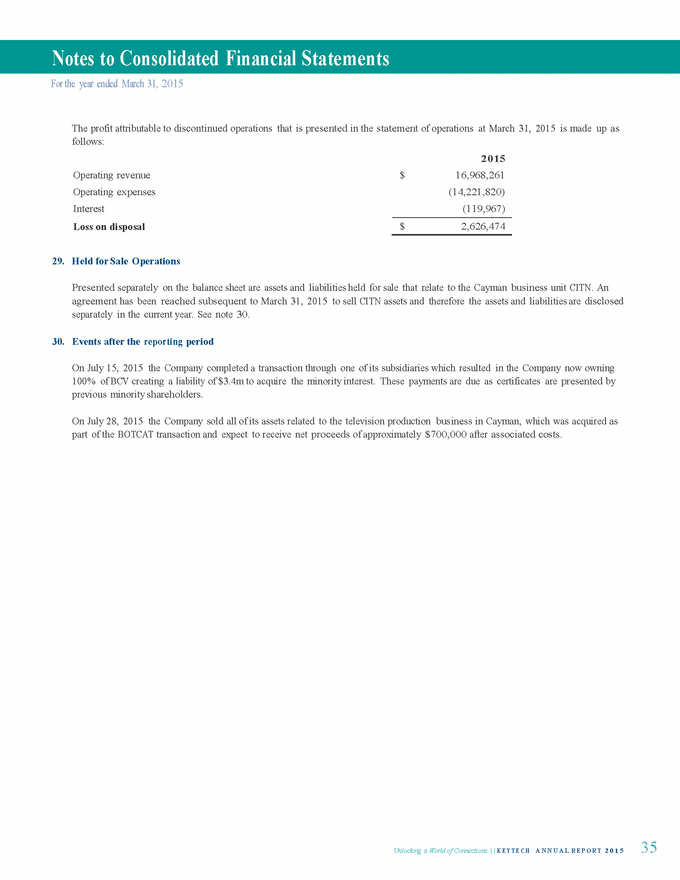
Executives and Officers Mr. Lloyd Fray Chief Executive Officer Ms. Leslie Rans, CPA Chief Financial Officer Mr. Michael Tanglao General Counsel Secretary Mr. Richard Lau Chief Technology Officer Mr. Philip S. Harris Director of Human Resources Common shares held by Directors – 663,080. Commons shares held by KeyTech Executive Management – 4,459 No rights to subscribe to shares or debt securities in the Company have been granted to, or exercised by, any Director, Officer or member of KeyTech Executive Management. There are no contracts of significance subsisting during or at the end of the financial year in which a Director was materially interested either directly or indirectly. 36
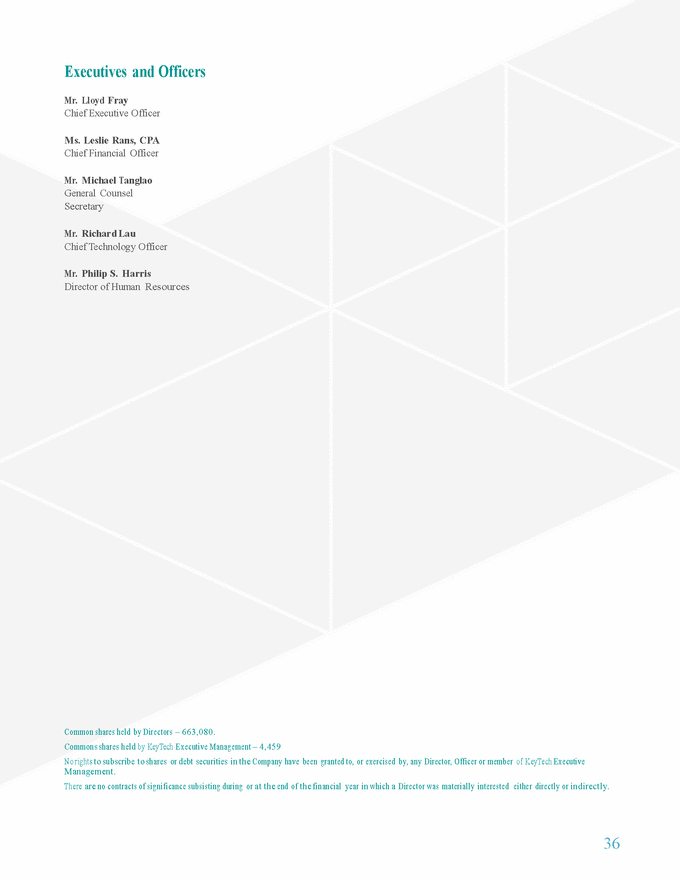
PRINCIPAL SUBSIDIARIES Logic Communications Ltd. 30 Victoria Street Hamilton HM 12 Bermuda www.logic.bm WestTel Limited (trading as Logic) 43 Eclipse Dr Grand Cayman Cayman Islands www.logic.ky Cable Co. Ltd. 30 Victoria Street Hamilton HM 12 Bermuda Bermuda Yellow Pages Limited Swan Building 26 Victoria Street Hamilton HM 12 Bermuda www.bermudayp.bm Bermuda CableVision 19 Laffan Street Hamilton, HM 09 Bermuda www.cablevision.bm KeyTech Limited P.O. Box HM 2445 Hamilton HM JX Bermuda Tel: +1 441 295 5009 Fax: +1 441 292 4984 www.keytech.bm
